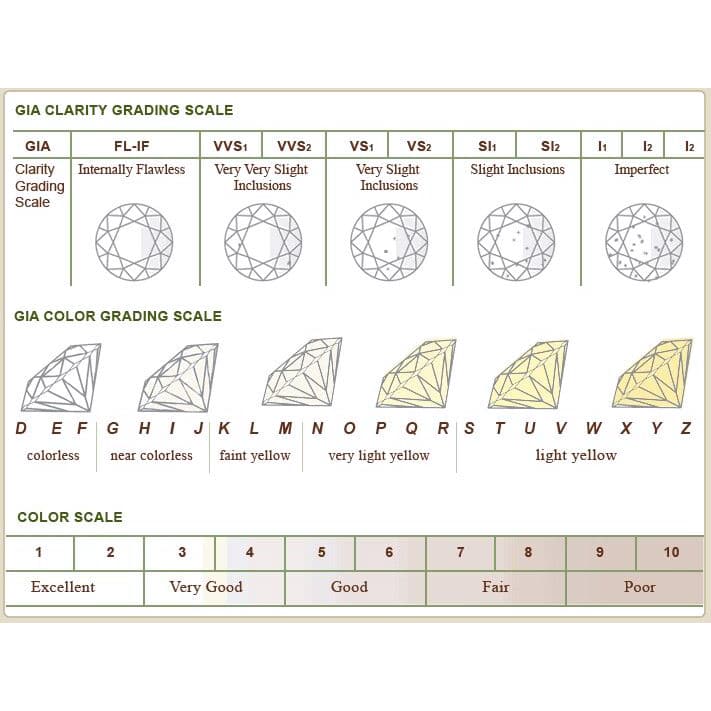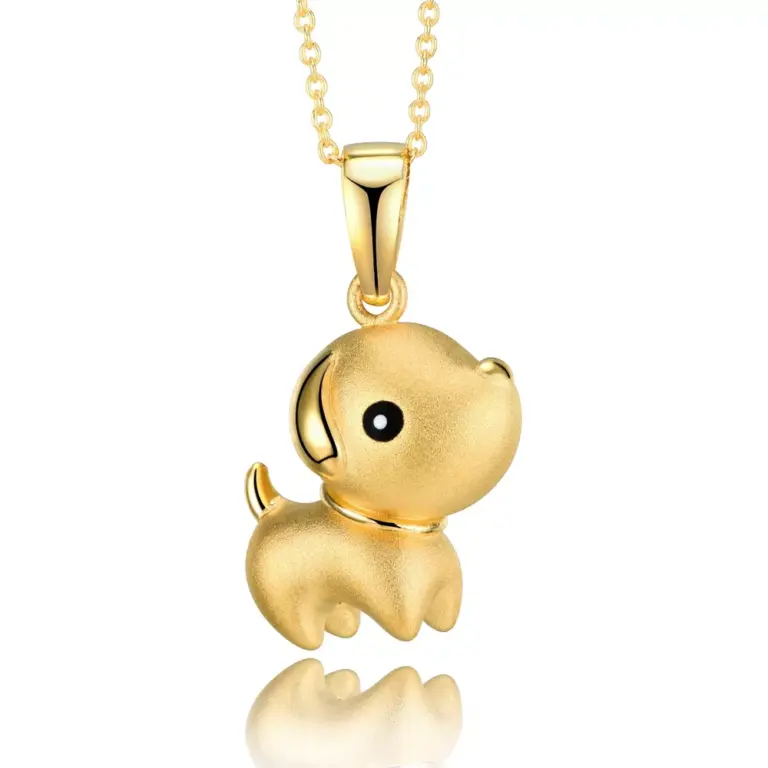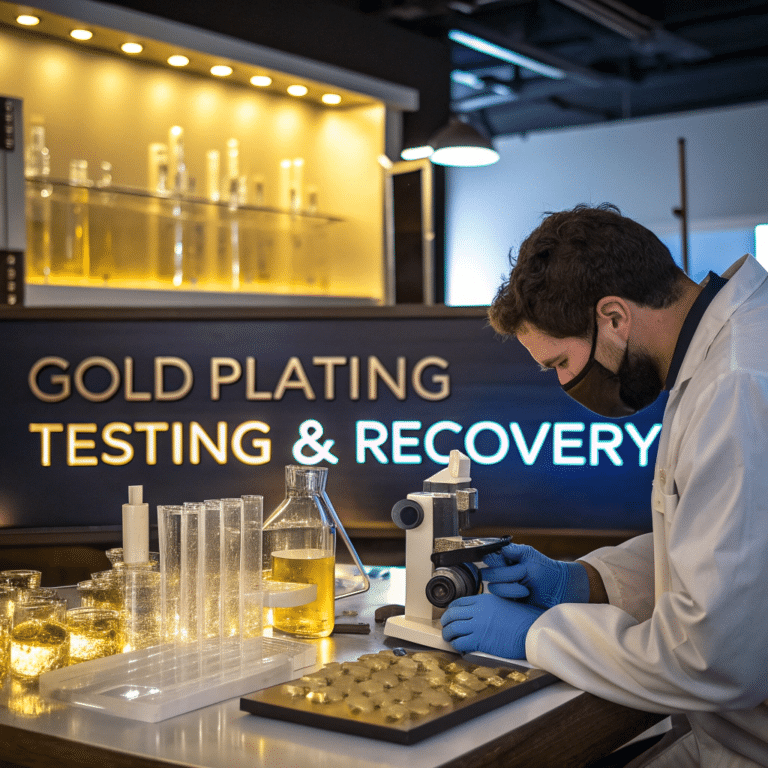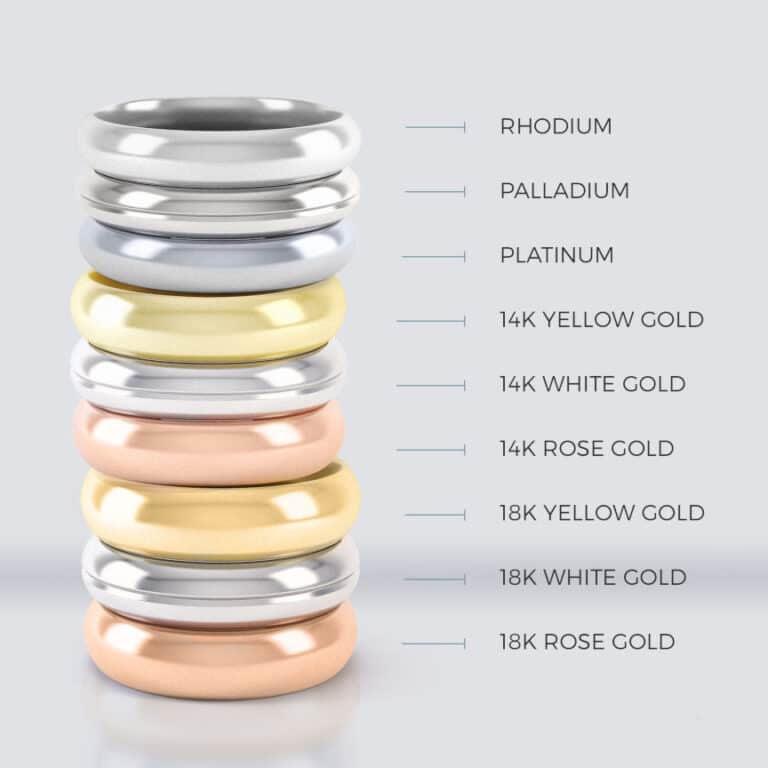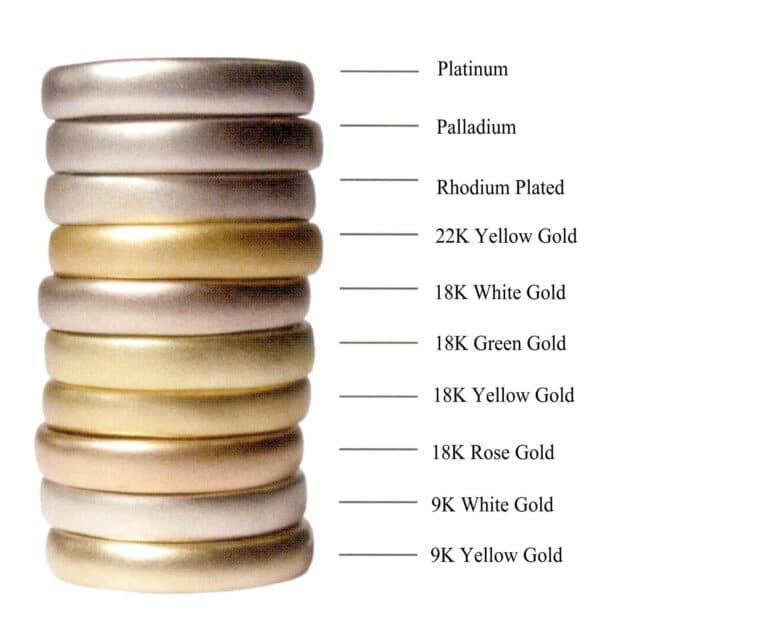Przewodnik konesera po kupowaniu kamieni szlachetnych: Wydanie dla początkujących
Odblokuj sekrety kupowania kamieni szlachetnych: Przewodnik dla miłośników biżuterii
Wprowadzenie:
Czy jesteś miłośnikiem biżuterii i szukasz najlepszego przewodnika po kupowaniu kamieni szlachetnych? Nie szukaj dalej! Nasz kompleksowy przewodnik ujawnia poufne wskazówki i sztuczki dotyczące wyboru najlepszych kamieni szlachetnych jak profesjonalista. Odkryj, jak kolor, szlif i przejrzystość wpływają na wartość klejnotu. Poznaj znaczenie pochodzenia kamieni szlachetnych i wpływ obróbki cieplnej na ich jakość. Odkryj prawdę kryjącą się za certyfikatami i dowiedz się, dlaczego nie są one jedynym potwierdzeniem autentyczności. Niezależnie od tego, czy jesteś właścicielem sklepu jubilerskiego, projektantem czy sprzedawcą detalicznym, ten przewodnik jest kluczem do dokonywania mądrych zakupów kamieni szlachetnych. Ponadto uzyskasz porady ekspertów, jak uniknąć typowych pułapek przy zakupie biżuterii podczas podróży. Wzbogać swoją kolekcję z pewnością siebie, wiedząc, że otrzymujesz najlepszą wartość za swoją inwestycję. Nie pozostawaj w niepewności - zostań ekspertem od kupowania kamieni szlachetnych już dziś!
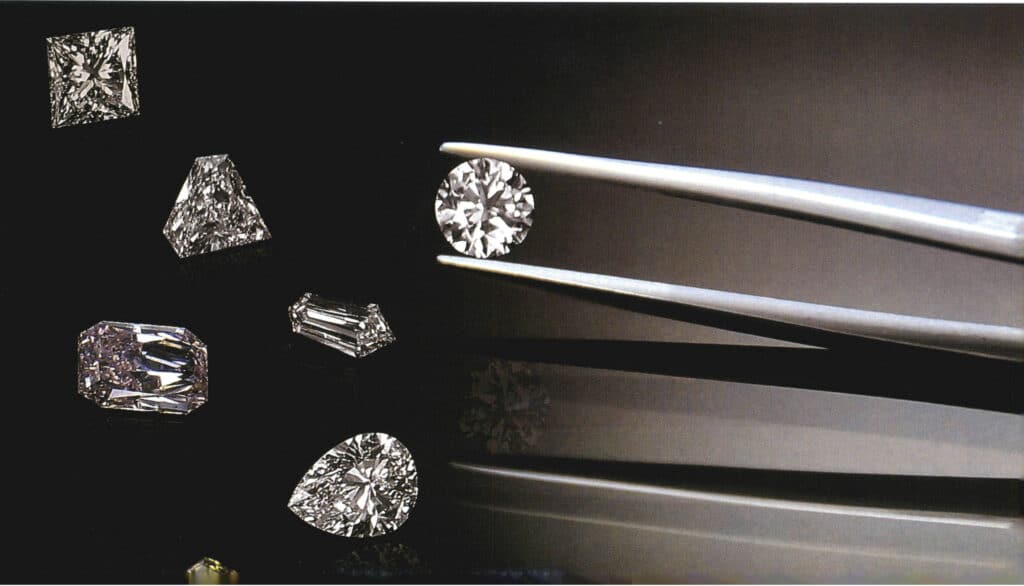
Spis treści
Sekcja Ⅰ Ogólne zasady kupowania kamieni szlachetnych
Cena kamieni szlachetnych zależy od takich czynników jak kolor, blask, inkluzje i zanieczyszczenia, przezroczystość, szlif, polerowanie i symetria, rzadkość źródła, polityczne aspekty pochodzenia, spekulacje rynkowe i globalna sytuacja gospodarcza. Jednak nadal istnieje pięć głównych zasad, których należy przestrzegać przy zakupie kamieni szlachetnych, którymi się teraz podzielę!
1. Pierwsza ważna zasada: Spójrz na kolor
- Im głębsze, bardziej nasycone, bardziej równomierne i bardziej żywe, tym lepiej
Każdy wie, co oznacza "miłość od pierwszego wejrzenia"; to wtedy, gdy widzisz coś po raz pierwszy i natychmiast to lubisz, odciskasz to w swoim umyśle, myśląc o tym dzień i noc, nie mogąc pozwolić temu odejść. Jak więc można "zakochać się" w kamieniu szlachetnym od pierwszego wejrzenia?
To bardzo proste; pierwszą rzeczą, jaką zauważamy w kamieniu szlachetnym, jest jego kolor. Przy wyborze wszystkich kolorowych kamieni szlachetnych i jadeitu, niezależnie od koloru czerwonego, niebieskiego, zielonego, żółtego, fioletowego itp. im głębszy, bardziej nasycony, bardziej jednolity i bardziej żywy kolor, tym lepiej. Postępując zgodnie z tą ogólną zasadą, pójdziesz w prawo. Ogólnie rzecz biorąc, w przypadku tego samego rodzaju kamieni szlachetnych, ciemne kamienie szlachetne są zdecydowanie droższe niż jasne; żywe kamienie szlachetne są również droższe niż ciemne.


Wśród kolorowych kamieni szlachetnych z tej samej rodziny, czarne i białe przezroczyste kamienie szlachetne są stosunkowo tańsze, takie jak czarno-biały turmalin, czarno-biały koral, czarny kamień gwiaździsty i biały korund, czarne diamenty (białe diamenty są wyjątkiem), czarne granaty (nie ma białych granatów) itp. Biorąc za przykład białe kamienie szlachetne, białe przezroczyste kamienie litonośne, biały spinel, białe korale, biały beryl, biały korund, biała cyrkonia, białe turmaliny i nieprzezroczysty biały jadeit są znacznie tańsze w porównaniu do kolorowych kamieni szlachetnych z tej samej rodziny (fioletowe kamienie litonośne, czerwono-niebieski spinel, czerwone korale, czerwono-zielony turmalin, czerwone szafiry, niebieska cyrkonia, akwamaryny i morganity, zielony i fioletowy jadeit itp.)
Oczywiście istnieją wyjątki, takie jak naturalne czarne perły, które są bardzo drogie (prawie wszystkie na rynku to perły hodowlane); dodatkowo czarny jadeit w jadeicie wydaje się czarny na powierzchni, ale pod bliskim oświetleniem ujawnia spokojny i powściągliwy ciemnozielony połysk, przyciągając wielu wielbicieli. W związku z tym jego cena naturalnie nie jest niska. Istnieją również wyjątki wśród białych kamieni szlachetnych z tej samej rodziny, takich jak szklany niebieski kamień księżycowy i szklany jadeit.
2. Druga ważna zasada: Patrz na cięcie
- Im mocniejszy ogień, tym lepiej.
Preferowana głębia kolorów kamieni szlachetnych różni się w zależności od prowincji, narodowości, pochodzenia etnicznego, a nawet płci i wieku, ale uznanie dla ognia jest niemal powszechnie podzielane. Kształt kamienia szlachetnego wpływa na jego piękno, niezależnie od tego, czy jest to serce, szmaragd, kwadrat, prostokąt, księżniczka, trójkąt, markiza czy łezka; Różne kształty różnią się w zależności od osobistych preferencji i potrzeb projektowych, ale im więcej jest faset, tym bardziej przezroczysty jest kamień, tym wyższy współczynnik załamania światła samego kamienia i tym czystsze wnętrze, co skutkuje błyskami ognia. Dlatego drugą zasadą, którą należy przyjąć przy zakupie klejnotu, jest to, że dobre proporcje cięcia, dobra symetria i dobry połysk w naturalny sposób wzmocnią ogień.
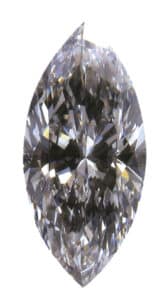
Marquise cut
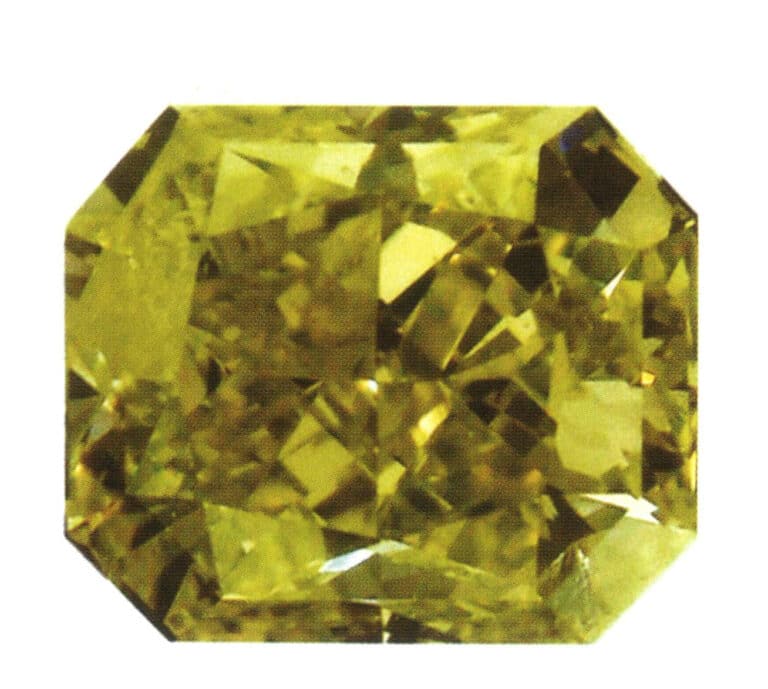
Szmaragdowy szlif

Krój księżniczki
Wskazówki dotyczące wyboru:
W przypadku birmańskiej bransoletki z jadeitu, cena rynkowa dziesięć lat temu wynosiła około US$940-1,566, ale obecnie wzrosła do US$3,134-6,268; w lipcu 2010 r. zapytałem o ceny na Guangzhou Hualin Jade Market w Guangzhou, a sprzedawcy podali US$18,420-21,254. Tymczasem nieskazitelna, przypominająca szkło bransoletka z białego jadeitu może obecnie osiągnąć cenę nawet $12,544-15,680 USD i może nawet nie być dostępna do kupienia.
Klejnot o nieskończonym uroku musi zostać poddany najbardziej odpowiedniemu cięciu, aby promieniować swoim czarującym blaskiem. I odwrotnie, jeśli proporcje cięcia są słabe, klejnot nie będzie świecił, a nawet może przeciekać światło. Taka sytuacja najprawdopodobniej wystąpi w przypadku diamentów i różnych cennych kolorowych kamieni szlachetnych. Sprzedawcy często zachowują niewielkie inkluzje, aby zachować wagę, dzięki czemu są one mniej zauważalne po osadzeniu klejnotu. Jest to również powód, dla którego wiele osób woli samodzielnie wybierać luźne kamienie przy zakupie klejnotów. Jednak kamienie szlachetne, takie jak kryształ, perydot, granat, fluoryt i topaz, które są stosunkowo niedrogie, można nie tylko zamówić w określonych rozmiarach lub kształtach. Można je również przycinać zgodnie ze standardowymi proporcjami, uzyskując niemal identyczny ogień dla każdego klejnotu.
Czym jest ogień Gem?
Ogień klejnotu odnosi się do światła załamanego wewnątrz klejnotu, widzianego gołym okiem pod oświetleniem. Im wyższy współczynnik załamania światła klejnotu, tym silniejszy ogień, który ludzie na ogół nazywają "bardzo błyszczącym". Klejnot klasy A ma dobry kolor, podobnie jak osoba o dobrej skórze; dobry ogień oznacza, że proporcje ciała danej osoby są dobre. Szczególnie w przypadku rubinów i szafirów ogień przyciąga wzrok, jeśli kolor jest jasny i nasycony. 1-karatowy czerwony rubin z birmańskiej krwi gołębiej może być wyceniony nawet na US$3,132-6,264, ale jeśli kolor jest nieprzejrzysty i brakuje mu ognia, jego wartość wynosi tylko około US$313-939. Jeśli kolor jest nieco jaśniejszy i zmienia kolor na różowy, ale ogień jest intensywny, cena może wynosić od US$939-3,132.
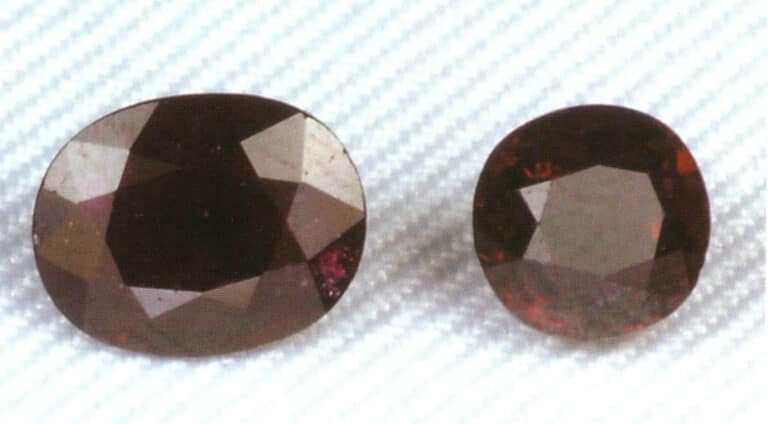
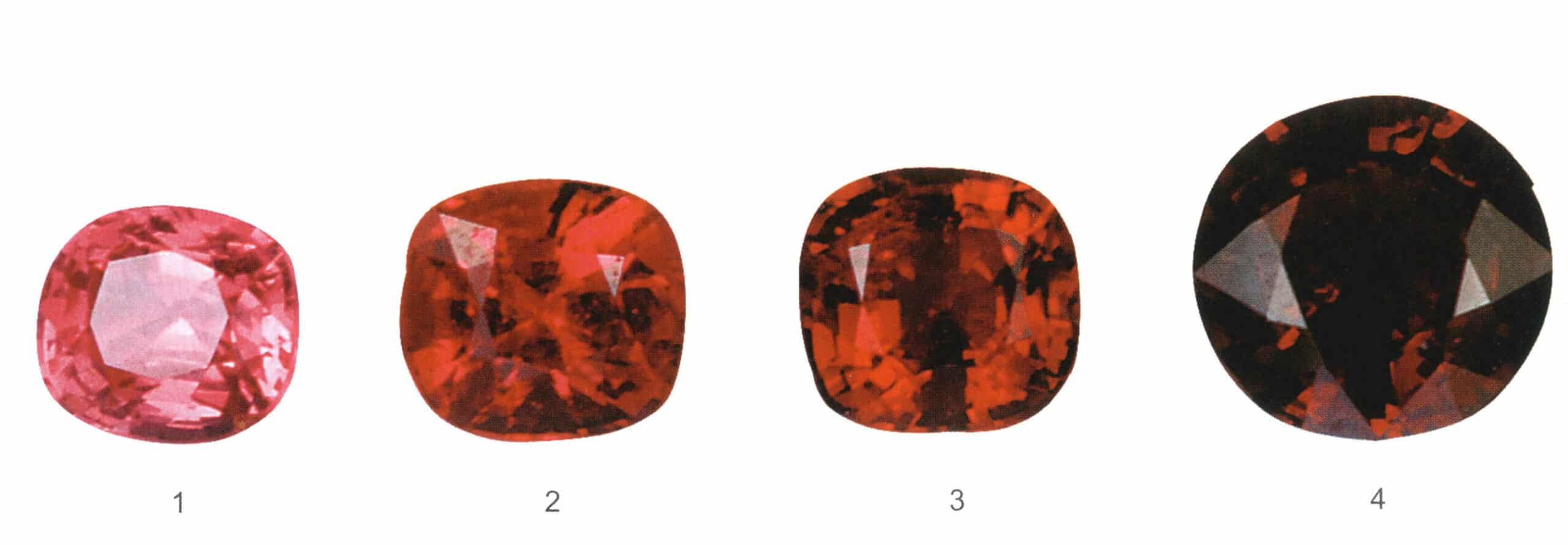
3. Trzecia istotna zasada: Zwróć uwagę na wtrącenia i pęknięcia
- Im czystsze, tym droższe.
Siła ognia jest również związana z wtrąceniami. Podczas formowania się kamieni szlachetnych, wychwytują one otaczające minerały i parę wodną, powodując powstawanie pęcherzyków, cieczy i stałych wtrąceń mineralnych. Wtrącenia są ogólnie określane jako "zanieczyszczenia" lub "wady". Przy wyborze kamieni szlachetnych, im mniej inkluzji, tym czystsze i bardziej przezroczyste, tym wyższa wartość. Ale paradoksalnie, całkowicie przezroczyste i nieskazitelne kamienie szlachetne (rubiny, szmaragdy) są wysoce podejrzane o to, że są syntetyczne.
Wśród różnych wtrąceń, pęknięcia są najbardziej tabu. Pęknięcia spowodowane szybkim chłodzeniem podczas obróbki termicznej kamieni szlachetnych lub pęknięcia generowane przez wibracje podczas cięcia i polerowania, a także małe wióry powstałe w wyniku zderzeń między kamieniami szlachetnymi po obróbce (przy czym spiczaste dna i obszary talii są najbardziej podatne na małe wióry) oraz zadrapania na fasetach, wszystko to obniży wartość kamienia szlachetnego.
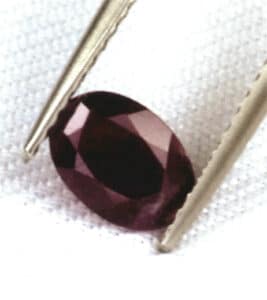
Bezogniowy czerwony rubin
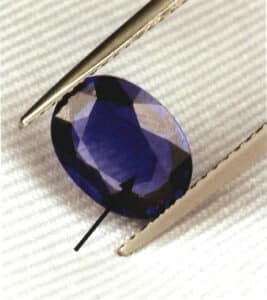
Szafir z wyciekiem światła w obszarze stołu i bez ognia
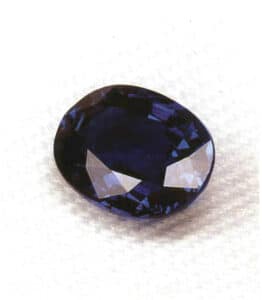
Szafir nie ma ognia w centrum i ognia na obrzeżach.
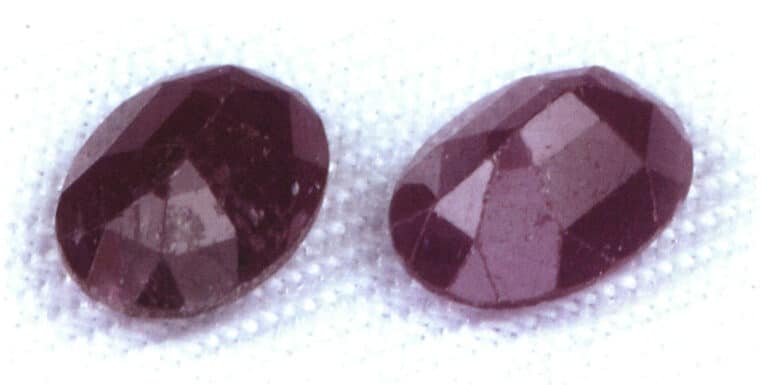
Czerwony rubin o porysowanej powierzchni
Jednak inkluzje niekoniecznie są wadą kamieni szlachetnych. Niektóre inkluzje mogą tworzyć efekt kociego oka; na przykład popularny ostatnio kwarc rutylowy, im wyższy współczynnik zawartości, tym wyższa cena. Naturalne inkluzje mogą być również wykorzystywane do weryfikacji pochodzenia kamieni szlachetnych, takich jak rubiny z Myanmaru, które zawierają minerały takie jak woda, ruda aluminium, rutyl i kalcyt. Niektórzy kolekcjonerzy biżuterii preferują nieobrobione czerwone i niebieskie szafiry; gemmolodzy mogą obserwować wnętrze kamienia, aby stwierdzić, że naturalne kryształy minerałów są nienaruszone i nie stopione, co wskazuje, że ten kamień szlachetny nie został poddany obróbce cieplnej. Jego cena może być od 30% do 50% wyższa niż w przypadku poddanych obróbce czerwonych i niebieskich szafirów.
4. Czwarta istotna zasada: Patrz na rozmiar i wagę
- Im bardziej widoczne, tym rzadsze.
Każdy wie, że kamienie szlachetne są mierzone w "karatach", gdzie 1 gram odpowiada 5 karatom (c.t.). 1-karatowy okrągły brylant ma średnicę około 6,3-6,5 milimetra. Ogólnie rzecz biorąc, ceny kamieni szlachetnych są obliczane za karat; na przykład 1-karatowy rubin kosztuje US$1,567. Jeśli ten rubin waży 5 karatów, całkowita cena wyniesie US$ 7,840. Konsumenci początkowo nie są przyzwyczajeni do tej metody ustalania cen (myląc 1 karat z jedną sztuką) i często błędnie uważają, że rubin kosztuje US$1,567. Prosimy o szczególną uwagę!
Wskazówki dotyczące zakupów:
Po tym jak surowa ruda zostanie pocięta i wypolerowana na surowe kamienie, zostanie ona wybrana przez sprzedawców kamieni szlachetnych za pośrednictwem pośredników, zanim zostanie przetworzona na gotowe pierścionki. Codziennie towary te oglądają dziesiątki osób. Jeśli nie ma indywidualnego opakowania dla każdego kamienia, fasety kamieni szlachetnych mogą zarysować się nawzajem podczas procesu selekcji, prowadząc do zużycia. Podczas oglądania szlifu należy zwrócić szczególną uwagę, aby upewnić się, że nie ma żadnych wyszczerbień, uszkodzeń lub zadrapań, ponieważ te wżery i wady nieuchronnie wpłyną na piękno i wartość kamieni szlachetnych. Niektóre z tych wad mogą być niewidoczne gołym okiem i wymagają użycia szkła powiększającego. Jeśli przypadkowo kupisz kamień szlachetny z zadrapaniami lub małymi wiórami, można go poddać ponownemu polerowaniu i cięciu, co zwykle kosztuje około $9-47 USD w Chinach. Istotne jest jednak, aby omówić z frezerem, ile wagi zostanie utracone podczas procesu szlifowania, ponieważ waga wpłynie również na przyszły rynek i cenę sprzedaży kamienia szlachetnego.
Bardzo czysty czerwony szafir lub szmaragd może mieć zaskakująco wysoką cenę. Dlatego też, jeśli chcesz mieć czysty kamień szlachetny i nie chcesz zostać oszukany, zaleca się, aby czytelnicy starali się wybierać kamienie, które nie są widoczne gołym okiem, ponieważ pod lupą lub mikroskopem zawsze będą jakieś inkluzje w kamieniach szlachetnych. Jeśli preferujesz całkowicie nieskazitelne kamienie, sugeruje się wybór kryształów, akwamarynów, topazów i innych kamieni szlachetnych, ponieważ te rodzaje skał mają mniej inkluzji i są preferowane ze względu na ich czystość i nieskazitelność.
TONKAF CUT
Znany również jako szlif milenijny, ponieważ został opracowany jako nowy szlif w 2000 roku. Kamień cięty laserem posiada widoczne grawerunki
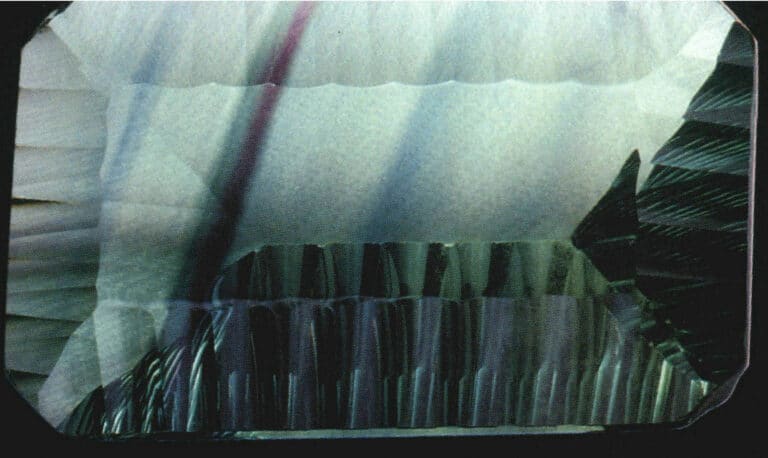
Zielony fluoryt
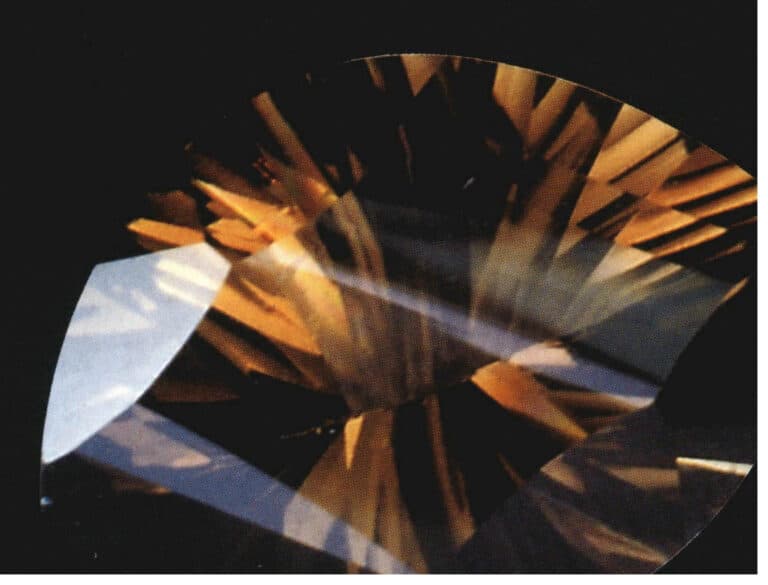
Kwarc dymny
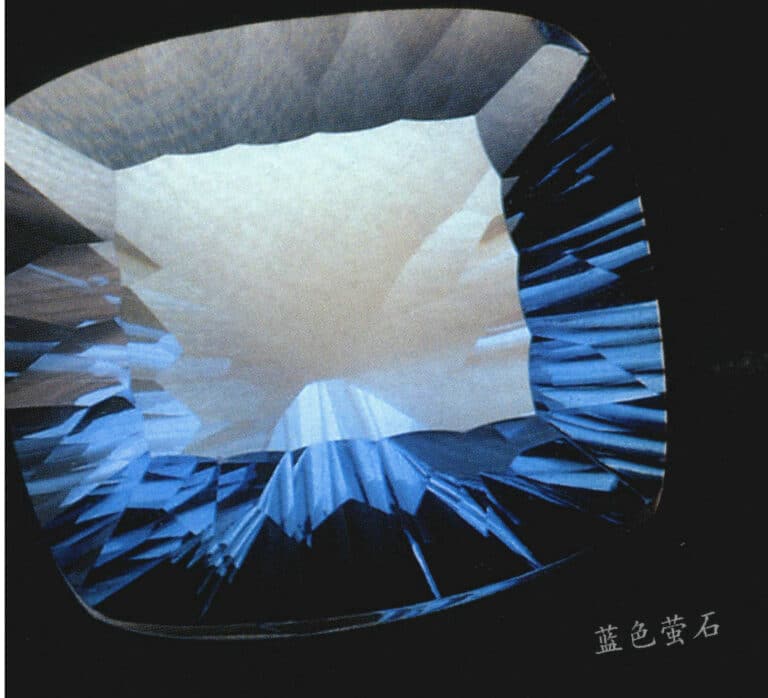
Niebieski żółty kamień
Cena kamieni szlachetnych jest powiązana z ich rozmiarem, ale nie są one sprzedawane według wagi, a większe kamienie niekoniecznie wiążą się z większymi rabatami. W przypadku diamentów tej samej jakości, jeśli 1-karatowy diament jest wyceniony na US$3,133, ile kosztowałby 2-karatowy diament? Odpowiedź bez wątpienia nie brzmi US$6,269, ale może wynosić między US$4,705-6,273 lub nawet więcej. Wynika to z faktu, że większe kamienie szlachetne są rzadsze. Biorąc za przykład birmańskie rubiny, 1-karatowy rubin jest wyceniany na US$1,568-4,701; 2-karatowy birmański rubin jest wyceniany na US$3,136-6,271 za karat, z całkowitą ceną około US$6,271-12,542; 4-karatowy birmański rubin jest wyceniany na US$7,840-10,975 za karat, z całkowitą ceną potencjalnie sięgającą US$ 31,356 do 43,905, co pokazuje znaczną różnicę w cenie.
Jednak w przypadku niektórych kamieni szlachetnych związek między wagą a różnicą w cenie jest nieznaczny. Na przykład cena za karat 1-karatowego topazu i 3-5-karatowego topazu nie różni się zbytnio. Ogólnie rzecz biorąc, te kamienie szlachetne mają większe kryształy i wyższą wydajność, a nawet mogą być cięte na zamówienie do określonych rozmiarów i kształtów.
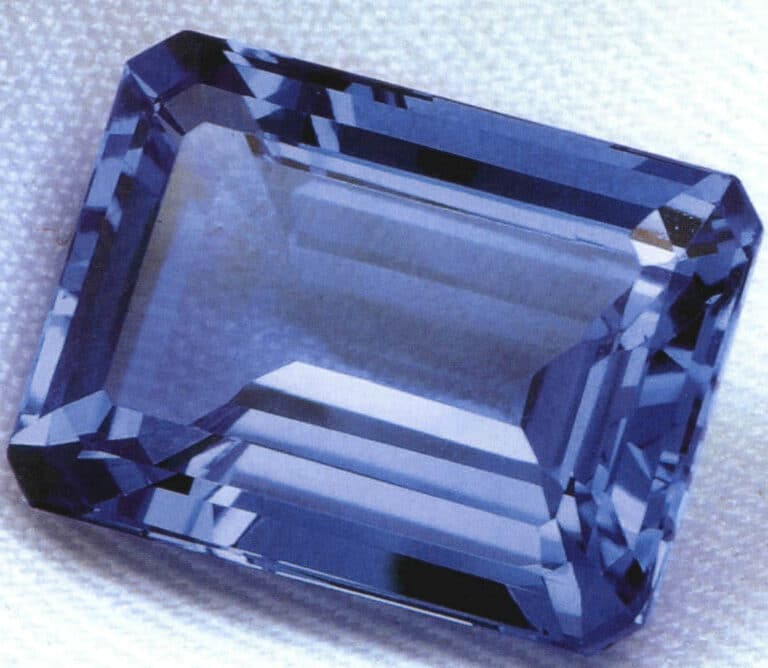
Szwajcarski niebieski topaz czysty i nieskazitelny
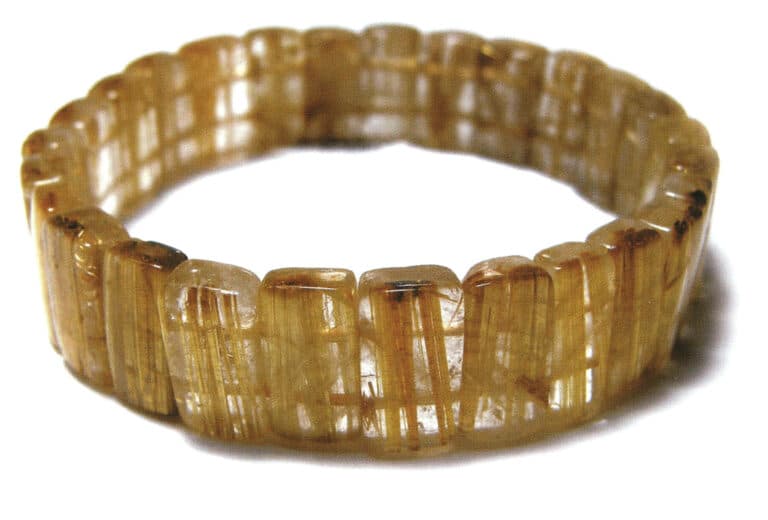
Kryształowa bransoletka pokazuje igłopodobne minerały rutylowe wewnątrz kryształu.
5. The Fifth sinificant rule: Look at the origin.
— It is even more important to consider the conditions of each gemstone itself.
Generally, the value of gemstones is closely related to their origin. People may have a few established impressions: the most beautiful peridot, ruby, and jadeite come from Myanmar; previously, the best sapphires were from Kashmir, but now those from Sri Lanka are more widely circulated; for South Sea black pearls, one must identify Tahiti; the most beautiful emeralds come from Colombia; the best diamonds are from South Africa…
Are there no beautiful gemstones from places other than these origins? Believing in origins is like believing in the origin of fruits; A-grade origin can guarantee value, but it is also inevitable that climate factors or human factors may lead to the production of lower-quality fruits. Similarly, there are different mines in the same country and the prices are vastly different. For instance, the prices of rubies from Myanmar’s Mogok and Mong Hsu regions differ significantly, with the latter being only 1/5 of the former.
What is heat treatment?
Heat treatment is the process of artificially heating natural gemstones (the heating temperature varies depending on the type of gemstone and its origin) with the primary purpose of melting the internal minerals of the gemstone, increasing transparency, or changing the gemstone’s color. However, it is essential to note that no coloring substances are added during the heating process; this method is generally referred to as “one-degree burn” by industry professionals. For example, green sapphires from the Thai market in the Macacha area will turn into yellow sapphires after heating; similarly, the Sri Lankan milk stone (milky white sapphire), which was initially considered worthless, contains rutile ( TiO2 ), and after heating, it can change from milky white to blue (the blue color change is mainly caused by the transformation of titanium (Ti) elements), becoming Sri Lankan blue sapphires. Once the color changes, it achieves a permanent chemical balance, and there is no need to worry about the color reverting or fading. Currently, heat treatment is accepted by gemstone dealers and appraisers worldwide, and consumers can confidently choose heat-treated gemstones.
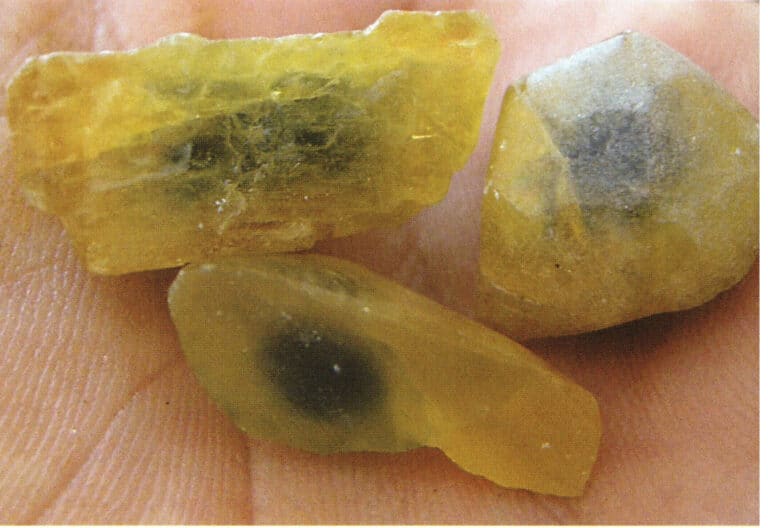
Additionally, the sellers often determine the origin or mining area of gemstones. Sometimes, gemstone wholesalers may incorrectly state the origin, and retailers follow suit. Moreover, many raw gemstones from various countries are sent to Thailand for cutting, polishing, and heat treatment, making it inevitable for some to be mixed up. So, how can consumers distinguish the origin? The answer is: observe more, ask more, and compare more to find clues. When selecting gemstones, paying attention to color, whether the fire sparkles, whether they like the cutting shape and the condition of impurities and transparency is sufficient for beginners. Understanding the origin of gemstones is a reference when purchasing and can also inform the seller that you are not entirely ignorant of gemstones. However, it is important to remind readers that diamonds do not have a specific origin because their inclusions cannot indicate their origin. If you ask when purchasing a diamond, “Is it from South Africa?” it may come off as inexperienced and counterproductive!
Purchasing Tips
Gemstones are priced based on weight, and some dealers do not polish the back to retain more weight, especially for opaque cat’s eyes or star stones. Readers should not think that dealers are cutting corners; the key is to check whether the front of the gemstone is perfect and flawless. Whether the back is polished is inconsequential, and one can even use this minor flaw to negotiate a better price with the dealer!
The size of diamonds reaching 1 carat also has a significant price difference. Comparing a 0.99 Carat diamond with a 1-carat (100-point) diamond, a 1-carat diamond with color D and clarity IF is priced at$23,100 (17/03/2009, RAPAPORT DIAMOND REPORT); the same conditions for a 99-point diamond are priced at $12,900. although the size difference between the two diamonds is only 0.01 carat, the price difference is as high as US$10,654. Therefore, diamond dealers will do everything possible to retain weight above 1 carat in their cutting.

Tahitian peacock green-black pearls have a metallic luster and are recognized as the best source of black pearls.

Pink Diamond Ring
Section II The Gemstone Buying Mindset Explained
Readers often hear sayings like “yellow sapphires can attract wealth,” “rose quartz can attract love,” and “buying gemstones can increase value.” Here, I present some views from a conscientious standpoint, considering the consumer’s perspective, hoping to provide readers with some thoughts to help them become smart consumers with their ideas.
1. Will wearing yellow crystals or yellow gemstones attract wealth?
It’s no secret that big bosses need to change their mindset, have innovative ideas, make their products competitive, actively participate in exhibitions, or promote through various channels to attract wealth in business. It’s hard not to attract wealth with such an approach. Moreover, wearing yellow crystals or yellow gemstones may attract wealth, but if one doesn’t work diligently, innovate actively, pursue clients, and make connections, just lying at home and hoping for money to come in is unlikely.
I have a reserved attitude towards whether wearing yellow crystals or yellow sapphires can attract wealth, but as long as it doesn’t cost a fortune or rely on claims from a particular master that require several times the price to obtain, positively changing one’s mindset and buying gemstones to attract wealth is not a dream!
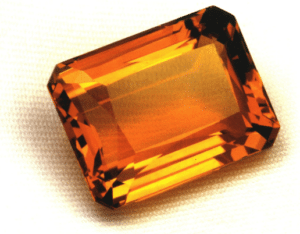
Cytryn
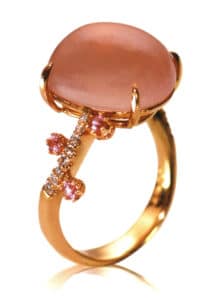
Rose quartz ring
2. Wearing rose quartz can attract love?
A Conscientious Advice is first to seek the beauty of the gemstone you like, which can match your identity and overall outfit or showcase your exceptional personal taste; secondly, consider any rumored additional value it may have.
To attract the opposite sex, you can train your sense of humor, pay attention to your clothing and appearance, exercise more to improve your physique, care for and help your friends, participate more in public welfare activities, and contribute more to clubs without expecting anything in return. With these qualities, no matter what gems you wear, people will appreciate you.
3. Can crystals increase energy? Wearing a Dzi bead can improve health?
When the body is in pain, one should go to the hospital to see a doctor and cooperate with medication or rehabilitation. Wearing crystals or Dzi beads given by friends reminds one of their blessings, which can improve one’s mood and provide a better chance for quicker recovery. I believe that sincerity brings results, so whether it’s buying yellow crystals, jade, yellow sapphires, amethyst, rose quartz, Dzi beads, bismuth, Chinese pi xiu, white crystals, sugilite, ancient jade, etc., as long as you like them and take good care of them, looking at these gems can be pleasing to the eye, and the heart will follow the environment. This can have a complementary effect anytime and anywhere, but one must not be overly superstitious and spend much money on purchases.

4. Can wearing jadeite ward off evil?
I often hear elders say that wearing jadeite (jade) can ward off evil, but this claim is complex to validate scientifically!
In China, it is common for mothers-in-law to prepare a single or a pair of jade bracelets as family heirlooms for their daughters-in-law because they believe that jade bracelets can help ward off disasters; we also often hear of some working women or homemakers who accidentally slip at work, and their jade bracelets break, yet they are unharmed. But on the flip side, many people, after wearing jade bracelets, are afraid of accidentally breaking them, so they become cautious in everything they do, avoiding clumsiness. Over time, a person’s temperament changes as well. Don’t you think this is a benefit of wearing jade bracelets?
If you believe that jadeite can ward off evil, then for the mineral itself, whether it costs $15.668 or $156,695, it has the same effect! Never give unscrupulous merchants a chance; be a wise and discerning consumer!
5. Buying gemstones can add value?
Let me give an example: In recent years, gemstones of the same quality, whether coral, jade, diamonds, ancient jade, emeralds, rubies, sapphires, or alexandrite, have seen their prices rise steadily. In 1995, I saw a flawless white jade bracelet in Hong Kong, priced at US$ 313, which is now worth US$12,534, and it may not even be available for purchase; ten years ago in Myanmar, I saw a piece of black jade that could be cut into two bracelets and two large pieces and dozens of ring faces, one piece is priced at US$281, while a similar quality is priced at US$ 4,073-4,700.
Buying gemstones basically increases the value, but the most important thing is appreciation! If you buy a gemstone of good quality and cheap, there will be room for appreciation; conversely, if you purchase a gemstone of poor quality and high price, it will be impossible to appreciate in the future. Therefore, I suggest that you often interact with people who play with gemstones to understand whether the gemstones you buy are reasonable and whether you purchased them at a high or cheap price. Over time, your appreciation ability will naturally improve, and the gemstones you buy will naturally have room for appreciation.
6. Is it easy to sell gemstones?
Unless it is in high demand in the market, any gemstone will have a slow cash exchange rate and many discounts. If you are in a hurry to sell, you will lose money! Therefore, when purchasing gemstones, prioritize whether you like them, and never think of making a big profit in the short term. If you want to sell, it is recommended to start with friends and fellow gemstone enthusiasts; they might have been coveting this gemstone for a long time. If this gemstone has appreciated a lot in value, the original jewelry store where you purchased it should also offer a higher price to repurchase it. But if you are in a hurry to cash out, you may only be able to find a pawn shop or online auction, and the price will likely disappoint you! For example, a 0.3-carat diamond ring bought for US$626-940 will usually be appraised by a pawn shop without considering the Karat gold price, so the recovery will only be about US$94-156, and it is rare to exceed US$156.
Section III Gemstone Clarity Levels
The grading standards for clarity were originally only used for diamonds. In recent years, due to the popularity of online auctions, sellers have adopted the diamond clarity grading standards for other colored gemstones to facilitate buyers’ judgments when they cannot see the physical items to avoid transaction disputes. However, apart from diamonds, the certificates for other colored gemstones only indicate color, whether natural or have undergone heat treatment or optimization, and their origin without specifying clarity levels.
| Level | Charakterystyka |
|---|---|
| IF | Completely Flawless |
| VVS | A very, very small flaw that is not easy to see even with a 10x magnifying glass. |
| VS | A very small flaw that can be observed with a 10x magnifying glass. |
| SI | A flaw visible to the naked eye that has affected the appearance. |
| I | Not suitable for wearing, but suitable for specimens |

Rubies with a flaw grade of SI have patches of feathery cracks visible to the naked eye.
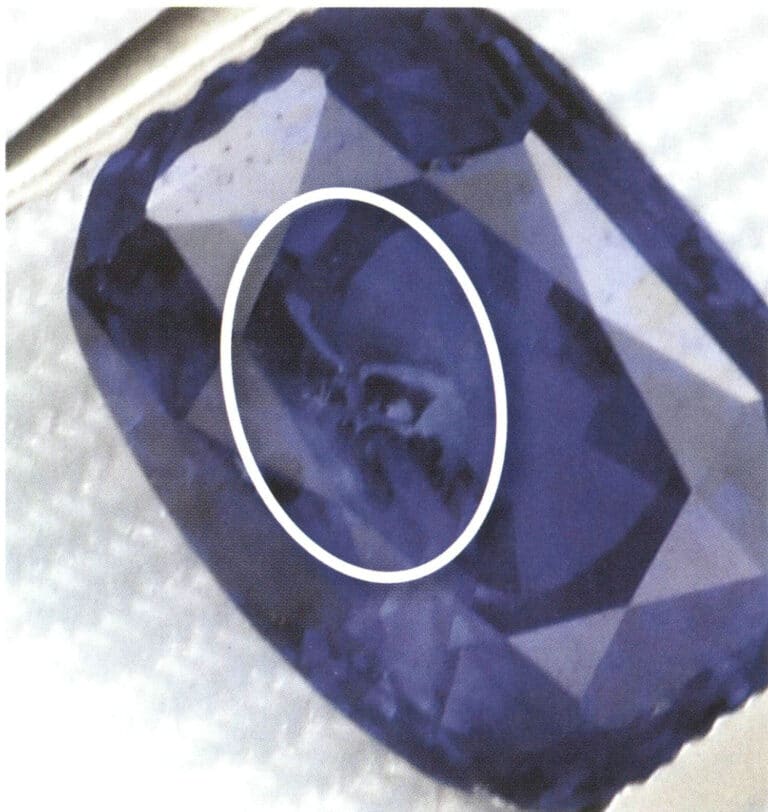
Sapphires with a flaw grade of SI have feathery cracks visible to the naked eye.
Section IV The quality of gem cutting
“This one has a relatively large bottom,” “That one has a bit of a tilt.” If readers hear such conversations between shopkeepers and customers while selecting gemstones, they should not mistakenly think they are commenting on street beauties. In fact, “bottom” is an industry term referring to the base of the gemstone. A large bottom means a deep base, generally producing more vital fire.
How do we determine if a gemstone is well-cut? We usually judge by the strength of the fire; a more vital fire indicates better cutting. For consumers, no matter how much sellers emphasize the table’s proportions or the pavilion’s depth, it is not good as seeing is believing. However, in the selection should pay special attention to gemstones with more oversized bottoms. Although they have an intense fire, they can be more labor-intensive to set. Some Sri Lankan sapphires have many facets, resulting in solid fire and a deep base. Compared to other gemstones of the same 1-carat weight, the bottom of the Sri Lankan sapphire takes up a significant portion of the weight, making the table appear smaller. Therefore, how to choose a gemstone with a beautiful fire that maintains a generous and elegant table size after setting depends on personal preference.

Generally speaking, the shape of the cut depends on the original conditions of the gemstone, aiming to minimize weight loss while shaping the stone. The quality of the cut shape is subjective and varies based on national conditions, personal aesthetic views, and the designer’s creative ideas, among other factors. Taking the jade statue of Guanyin (Sanskrit: Goddess of Mercy) as an example, Chinese people prefer a round face shape for Guanyin (Sanskrit: Goddess of Mercy), while Thai people like a slender face; for instance, young girls may prefer heart-shaped cuts, while friends who are just learning jewelry setting might prefer round-cut gemstones that are easier to set. Some designers require very strict cutting proportions, with length, width, height, and symmetry being meticulously adhered to, while other designers particularly enjoy selecting oddshaped gemstones, which may seem like a disadvantage to the average person (as the gemstones are relatively cheaper). Still, designers see their uniqueness and skillfully design them into shapes of turtles, lizards, butterflies, dragonflies, snakes, and other animals, giving the gemstones new life and creating higher gemstone value.
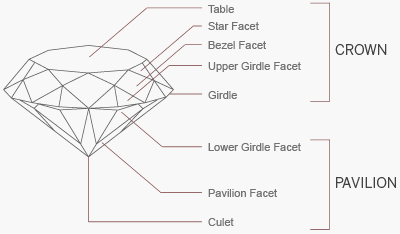
It is important to remind readers that the shape of the cut has little impact on the price! For gemstones of the same color, weight, inclusions, and brilliance, the price difference for different shapes is around 10%. So, do not believe the store or salesperson’s claim that “special cuts are sporadic, so a certain percentage must increase the price.”
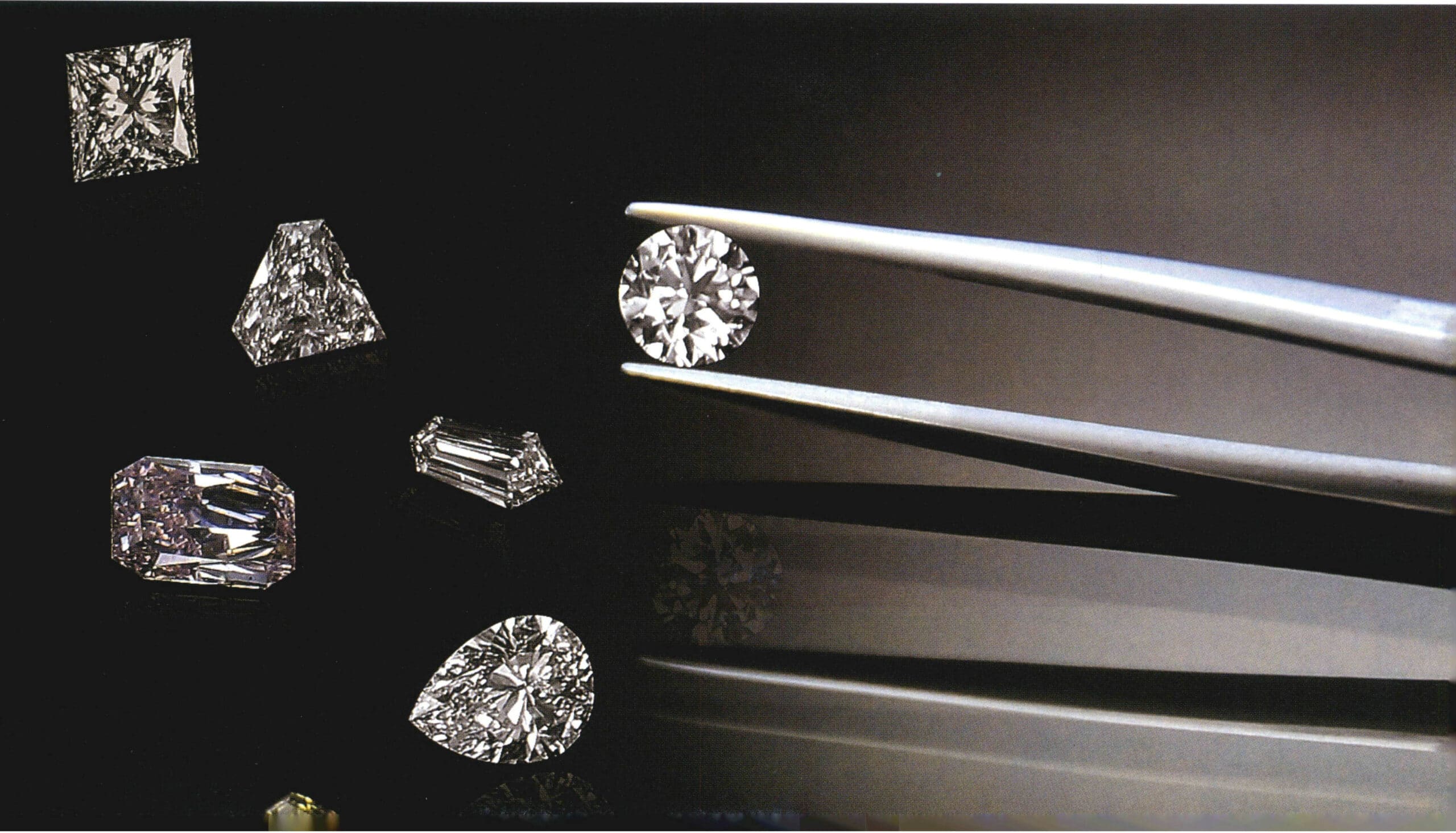
Section V Optimization treatment
To make the most of the materials, general practitioners will only abandon gemstones if they are lighter, uneven, and colorless. Still, they will try to make them more beautiful and appealing. This method is akin to human cosmetic surgery procedures, called “optimization treatment.”
There are mainly two ways of optimization treatment: one is to add color to the outside of natural gemstones to make them more uniform, more vibrant, and more profound in color, or to change the color; the second is to remove cracks or dark inclusions in natural gemstones through special laser treatment or to fill the cracks in the gemstones with glass or silicone. Below is a brief introduction to several standard gemstone optimization treatment methods.
1. Optimization treatment of rubies and sapphires
The industry’s most common optimization treatment for rubies and sapphires is adding chromium oxide to some colorless corundum, which will turn it into ruby; adding iron oxide and sodium oxide will turn it into sapphire. This method was widely adopted around 1993 to 2000 and is commercially known as “second heating.” There are now methods to verify this, making it easy for appraisers and consumers.
Since around 2003, new technology has involved heating colorless corundum with beryl, which allows the beryllium in the beryl to penetrate the corundum, turning the white corundum into very bright orange, orange-red, or red. Suppose consumers see red or orange corundum that is vibrant in color and not too expensive (usually priced at US$ 94-156). In that case, they should be particularly cautious about whether it has undergone beryllium optimization treatment. When beryllium-treated rubies first appeared, the industry was deceived and rushed to buy them; some early buyers even purchased beryllium-treated rubies for 10,000 New China Dollars per carat. After the beryllium treatment technology was made public, the price of 1 carat of beryllium-treated rubies dropped to less than US$15.
What is second heating?
Second heating does not mean heating twice; it means adding iron oxide to lighter-colored natural rubies or colorless corundum to turn them into blue sapphires and adding chromium oxide into red rubies. This method of adding foreign substances to change the color of gemstones is referred to as second heating by the industry and is academically known as “diffusion treatment”. The price of rubies and sapphires that have undergone second heating is 1/5-1/10 times that of natural rubies and sapphires.
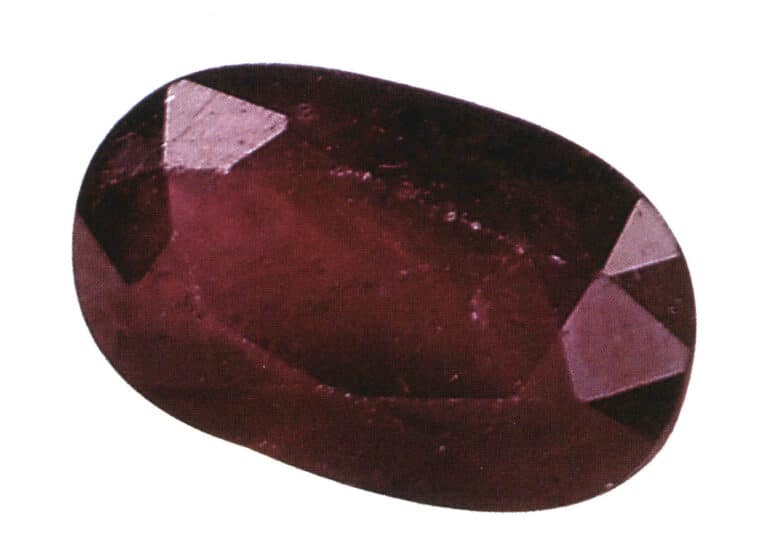
In addition, many African rubies (opaque, with many cracks) are filled with glass or silicone to fill the gaps. Special care should be taken with gems treated with this technology; they cannot be directly electroplated during setting, as this can cause acid-base effects, and the high temperature of electroplating can melt the filled glass and silicone. It is also worth noting that some gems with softer hardness or developed cleavage and many cracks, such as spodumene, kunzite, and kyanite, are advised against direct electroplating to avoid damage to the gems and potential consumer disputes.
2. Radiation treatment of diamonds
The most commonly used optimization treatment for diamonds is radiation heating. Through radiation, diamonds can change from white to color. Typically, the market price for a 1-carat natural blue diamond is between US$94,017-156,700. If it is a radiation-treated blue diamond, 1 carat only costs US$4,699-6,266, and online, it can be found for around US$ 1566.
Does wearing a diamond that has undergone radiation treatment affect the human body? Although gems that have been irradiated must wait until the radiation has decreased to a safe level before they can be sold, just like houses with low-pollution radiation-reinforced steel or those near mobile phone base stations, even if the price is low, most people still hesitate to live there. Similarly, houses with radiation-reinforced steel do not appreciate; irradiated diamonds will not increase in value simply due to age. Therefore, it is recommended that consumers who want their diamonds to appreciate should still purchase natural diamonds.

Precious color-changing diamonds
Under normal light, the diamond appears olive green, and after slight heating, it instantly turns orange-yellow; once the temperature drops, it returns to olive green. The color of the diamond changes with light and temperature, hence the name “chameleon,” making it a very precious diamond. Do not mistakenly think it is due to optimization or heat treatment. It is also important to note that not every diamond will change color, so consumers should not attempt to replicate this at home to avoid damaging it.

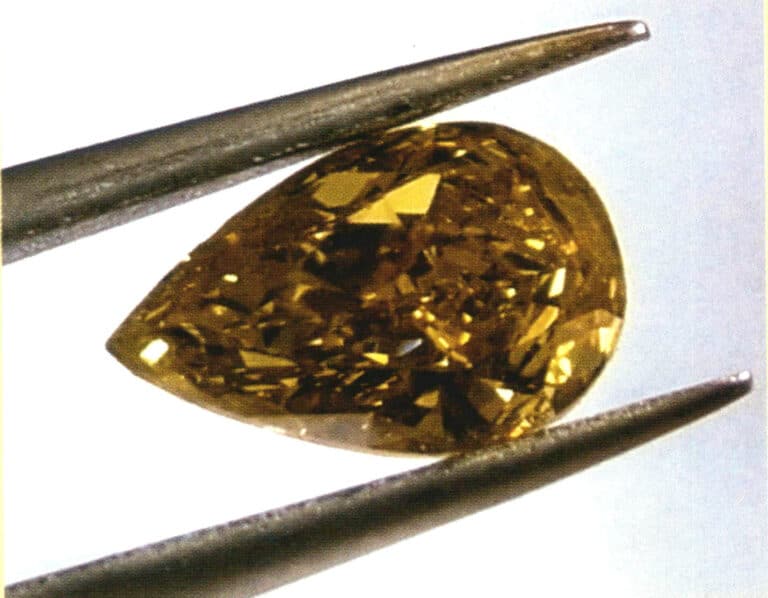
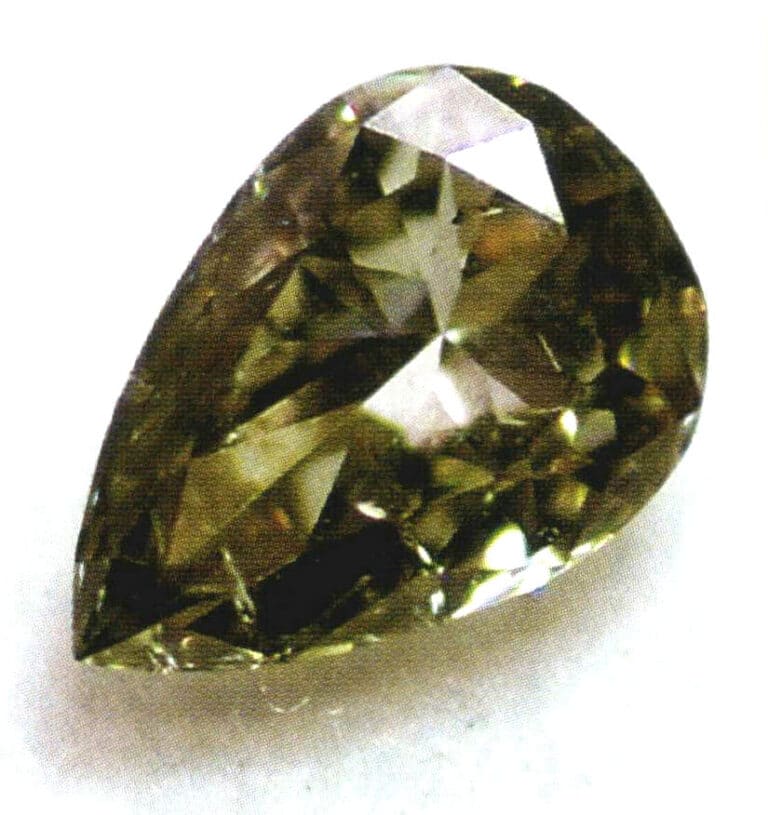
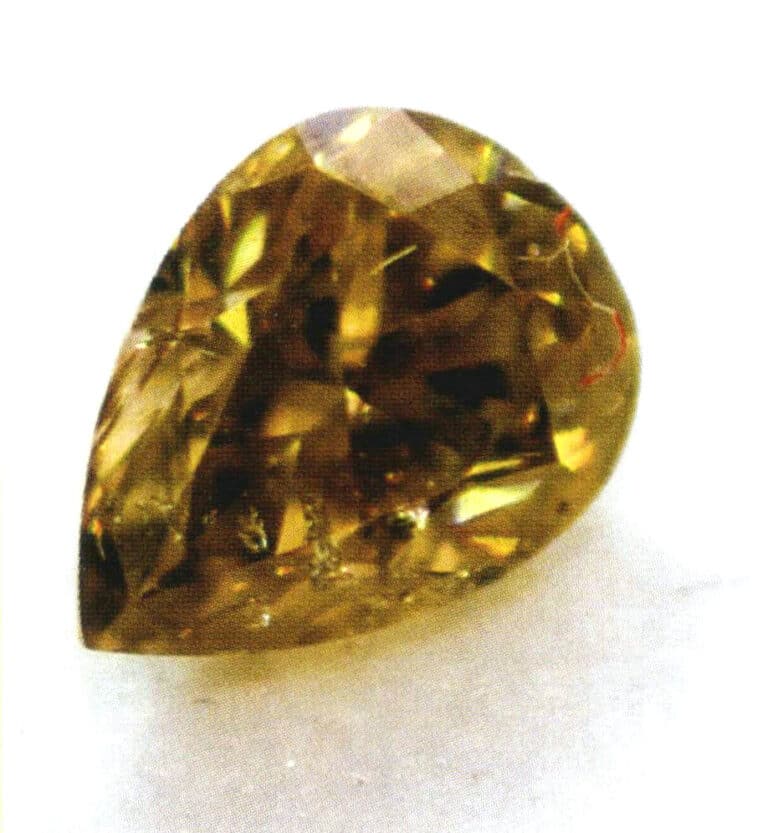
Additionally, lasers can be used to remove impurities from diamonds and refill the laser holes with lead glass to improve the diamond’s clarity; some diamonds are treated with high temperature and pressure to turn yellow or brown diamonds into bright yellow-green or to make brown diamonds colorless (a technology invented by General Electric, and diamonds treated with this optimization have “GE POL” engraved on their girdles). Some diamonds that have undergone optimization can be identified with a magnifying glass or microscope, while others require assistance from high-tech instruments. If you are concerned about purchasing diamonds that have been optimized, choose diamonds with GIA certification and pay special attention to any records of optimization treatment for relative assurance.
Copywrite @ Sobling.Jewelry - Producent biżuterii na zamówienie, fabryka biżuterii OEM i ODM
3. Optimization treatment of jade (jadeite)
There are four standard methods for processing jade (jadeite):
First:
it has not undergone vital acid treatment, only a process of soaking in sour plum water to remove the grease from the cracks, but it does not affect the quality of the jade. This type of jade (jadeite) is called “A-grade” in the jade market. A-grade jade will become brighter the more it is worn, as the skin’s oil fills the jade (jadeite) cracks, making it warm and colorful, which is generally acceptable (non-optimized treatment).
What is the difference between jade and jadeite?
Jade is a general term that includes Jadeite, Nephrite, Chinese Jade, etc.; jadeite is also a type of jade. In China, jadeite refers to various colors of Burmese jade, including blue, yellow, red, black, and purple, all called jadeite. When trading jadeite, you often hear, “The water transparency is perfect,” which means the transparency of the jadeite is very high. Additionally, it is essential to clarify a misconception. Many people think jadeite is produced in mainland China, but most jadeite comes from Myanmar and is then transported to mainland China for processing and carving. Mainland China does not produce jadeite!

Fire-roasted jade skin color-changing bracelet
If the surface of the jade has yellow jade skin, it can be heated with a hydrogen-oxygen flame to turn the jade skin red. Some unscrupulous merchants will sell it as blood jade. Upon careful observation, the surface of the fire-roasted jade skin will have fine cracks.

B Grade
Burmese jade bracelet, transparent like glass, usually with a hint of purple.
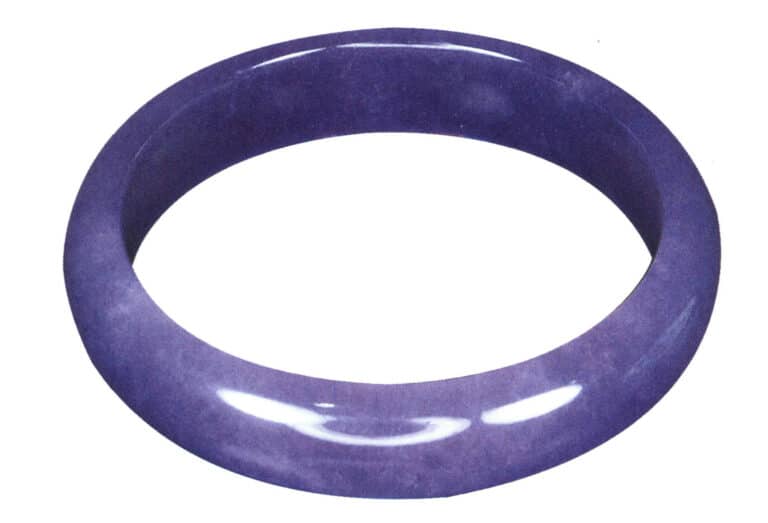
C Grade
Dyed violet. Burmese jade bracelet.
Selection Tips:
If you had to choose between two bracelets, one is brown with impurities and is relatively expensive; the other is clean and has no impurities, priced at only 1/3 of the former; which one would you choose? Most first-time buyers of jade would choose the latter, only to end up with B-grade goods. If you have had even a slight exposure to gemology, you would know that jade is usually meant to be worn frequently, and A-grade goods become shinier the more they are worn. If you see someone wearing an all-green bracelet on the street, there’s no need to envy too much, as 99% is dyed C-grade goods. Because a jade bracelet that is both green and translucent, with even color, is valued at US$625,520-3,127,900, most people only wear it at important banquets or social events; no one would casually wear it to a vegetable market or night market. If it accidentally breaks, it would be a tearful situation!
Second:
due to the secondary changes in jade (oxidation), minerals like iron oxide can form, causing the jade (jadeite) to turn yellow or red. Therefore, dealers will use strong acid to dissolve the impurities on the surface of the jade (jadeite) to make it cleaner; then, they fill the cracks with silicone to prevent the jade pendant or bracelet from breaking. Jade, who has undergone this optimization treatment, is called “B-grade.” Although B-grade is cleaner, with green areas appearing green and white areas appearing white, the structure becomes loose due to the vital acid treatment, and the silicone on the surface can turn yellow due to weathering, so it does not become shinier with wear.
Third:
there is the “dyed” optimization treatment. Jade (jadeite) that has undergone dyeing treatment is generally called “C-grade” in the industry. With current dyeing technology, dyed jade (jadeite) is not easily discolored. Therefore, we often see colorful dyed bracelets in the jade market, which usually cost only several US dollars . Additionally, A-grade bracelets that are whiter and have more impurities are sold for only US$9.38-46.908 in the jade market or online shopping, but dyed bracelets are valued at only several US dollars. Some unscrupulous sellers online, however, may sell them for US$93-156, and when consumers ask questions, they either avoid the topic or delete the questions altogether; some even ask friends and family to buy online to create fake positive reviews to reduce consumer doubts. Consumers must be cautious to avoid being taken advantage of.
Fourth:
after removing the color impurities from jade (jadeite), colored silicone is used to fill the surface cracks of the jade (jadeite). Jade (jadeite) treated in this way is referred to as “B+C grade,” it typically does not fade over time. Many of the jade (jadeite) sold in vegetable markets or night markets are of this type, often priced from several US dollars to tens of thousands of dollars, allowing consumers to bargain freely, ultimately selling for around US$31-93.
4. Optimization treatment of other gemstones
In addition to the gemstone above optimization treatments, other common ones include optimization treatments for gemstones such as turquoise, emerald, pearl, topaz, crystal, and agate.
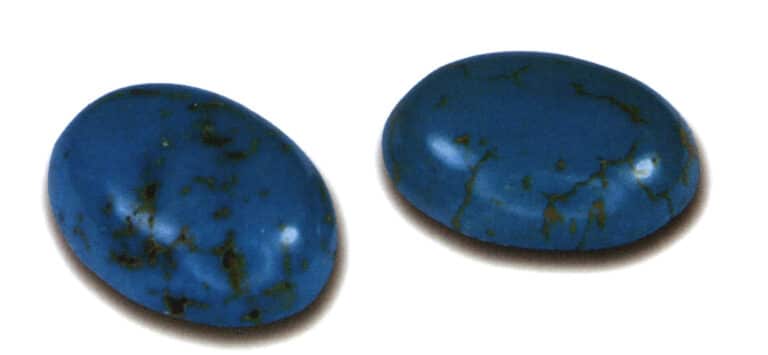
Dyed Turkish stones, even the stone patterns on the stones are imitated so well that even experienced experts sometimes look away.
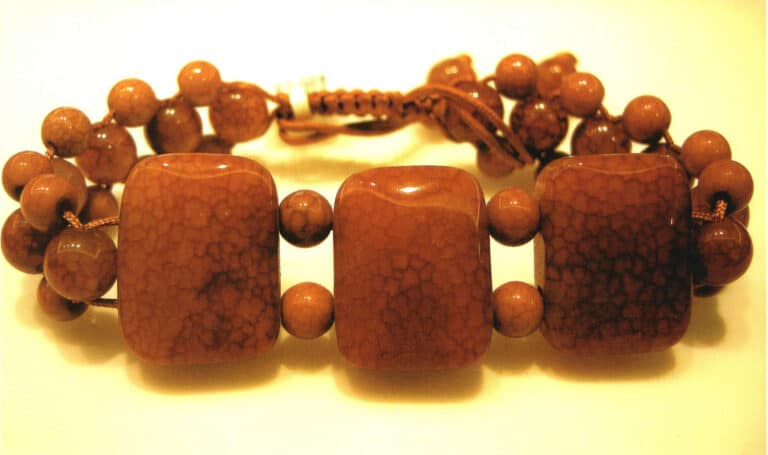
Dyed red chalcedony, with clear visible sediment patterns from the dye penetrating the surface.
The carved red agate on the market (mostly red) usually undergoes silicone gel treatment first due to many cracks, followed by carving and polishing to prevent breakage. Some cut surfaces of the agate may have undergone heat treatment, which is not an optimization treatment, so do not confuse them.
The optimization treatment for emeralds involves soaking them in green oil (soaking in white oil is acceptable in the industry). When purchasing valuable emeralds, looking for those with a GRS certificate is recommended to ensure quality.
Natural golden pearls are quite rare. If a whole string of golden South Sea pearls has each pearl with a diameter of 12-13 millimeters, with saturated and even color, the price ranges from US$4,690-9,381. Logically, this should be dyed from white South Sea pearls. If it is a natural golden pearl necklace, the market price should range from US$25,017-31,272, depending on the pearls’ cleanliness, roundness, and color depth.
Natural white topaz turns blue after radiation treatment. However, since the price of topaz is not high, the market price is about US$3.12-9.38 per carat. Usually, sellers do not specifically mention that it has been treated. Additionally, pink topaz is coated with a thin film. If you like its color, it is also A-grade accessory for not spending too much money [1 carat US$3.12-6.25].
Green and colorful crystals, black, red, purple, and blue agates, all undergo color enhancement treatment, and consumers must pay special attention!

Due to their darker color, Thai sapphires need to undergo heat treatment to change into yellow sapphires. After becoming yellow sapphires, their price can increase several times to dozens of times compared to sapphires (depending on the weight of the gemstone).
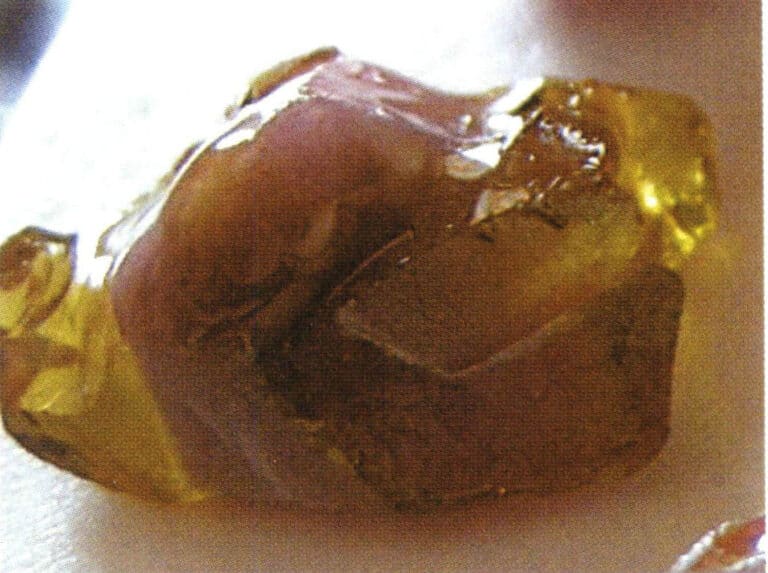
Treated gemstones
5. Optimized gemstones are cheaper than natural ones.
In the past, consumers worried about whether gemstones were fake or synthetic. Now, with advanced identification technology, consumers need to pay attention to whether gemstones have been treated. Like food packaging must indicate artificial additives, sellers should also disclose if gemstones have been optimized. Optimized gemstones are not unbuyable; rather, one should not be deceived by the beautiful colors of gemstones and end up paying too much. If consumers know that a gemstone has been optimized but still find it pleasing to the eye and are willing to buy it at a relatively low price, it is also a nice choice.
Generally speaking, optimized gemstones are definitely cheaper than natural gemstones (usually, the market price is only 1/5-1/10 of natural gemstones). For example, Padparadscha sapphires, which are orange with a hint of pink, have a market price of US$938-1,563 for a 1-carat stone. In contrast, the market price for a 1-carat optimized orange sapphire does not exceed US$31.27.
Why is heat treatment acceptable?
Industry professionals commonly refer to heat treatment as a “one-degree burn.” Gemstone heat treatment is similar to how an egg is heated in an electric stove, achieving a similar effect to that of a hen laying an egg naturally. Gemstones buried underground are affected by the geothermal gradient, changing color over tens of thousands to millions of years. Without adding any coloring elements, humans use electric stoves to change the color and transparency of gemstones in a short time (from a few hours to several months), and this method of heat treatment has been accepted by gemstone professionals, appraisers, and consumers worldwide.
Section VI Be careful when buying jewelry when traveling
Many people in China travel off the island in group tours. Consumers should be cautious if the tour fee is very low or not enough to cover the airfare. These tours usually include “shopping” itineraries, and you must buy something. For example, in Shanghai, you might visit places selling jade, and pearls; in Thailand, you might see red, blue, and yellow gemstones; in Zhuhai and Shenzhen, you might visit places selling pearls, and jade, and most of the time, you will have to spend money. The wool comes from the sheep; no one will do a losing business. Usually, the jade and pearls bought in those places will likely be dyed or B-grade jade and plastic beads. If you are not knowledgeable about gemstones, please think twice before purchasing.
Usually, buying red and blue gemstones in Thailand often means you are overpaying; in Cambodia, you might buy a synthetic blue sapphire for US$156.36; in Myanmar, it is easy to buy dyed jade rough stones or synthetic red gems on the roadside; in Singapore, the most commonly bought are lab-created emeralds; in the Philippines, it is easy to buy black glass beads posing as black pearls; in Russia, it is easy to buy reconstituted amber; in Austria, you might mistakenly think that the well-known brand crystals (glass) are natural. Consumers traveling in groups to gemstone-producing areas should not think they will find particularly cheap jewelry. However, if you want to show off and display your identity and status by spending a lot of money on jewelry, local tour guides and travel agencies will surely thank you with a mix of smiles and tears! Lastly, a reminder: when buying jewelry in Thailand, you can quickly contact the travel agency for a refund if you feel dissatisfied with the quality after returning. The sooner you request a refund, the higher the amount you can get back. You can contact the local consumer association if the travel agency deliberately delays.

Synthesized rubies
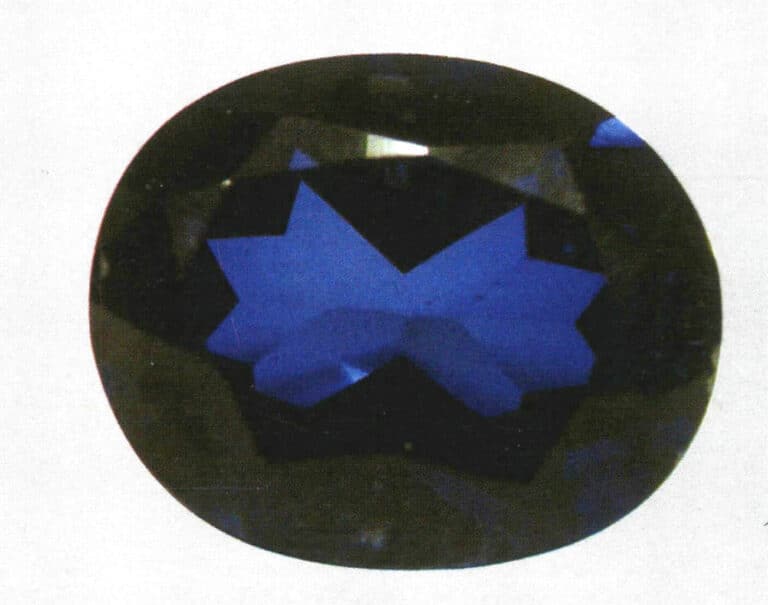
Syntetyczny szafir
When traveling, the most commonly bought items are these clear synthetic red and blue sapphires (synthetic corundum). Natural red and blue sapphires usually have some inclusions. If the red and blue sapphire is very clean and the price is not high [US$93-156, you should be cautious about whether synthetic.
Section VII Afraid of being scammed, is having a certificate enough?
Many consumers mistakenly believe that having a certificate when buying gemstones is sufficient; as long as they can afford the appraisal fee, they can obtain a correct appraisal report to ensure the authenticity and grade of the gemstone. But let me ask: does the report from a public hospital guarantee your health? Similarly, does having a gemstone certificate mean you have bought a high-quality item? Not necessarily; the most important thing is to understanding the content described in the gemstone certificate.
Many diamonds in the market claim to come with a certificate from the Gemological Institute of America (GIA), but if the flaws and cut grades indicated on the certificate are relatively poor, the value of the diamond will stay the same even if it has a certificate. A consumer who bought a GIA-certified emerald while traveling in Singapore, thinking they had purchased a genuine item, and was very happy; five years later, when they took the gemology class at a community college, they discovered they had bought a “synthetic emerald.” When they cried foul, they had no recourse because the GIA certificate clearly stated it was a “synthetic emerald”! Therefore, while having a certificate is important, understanding the certificate’s content is key point.
1. How do you interpret a GIA diamond certificate?
Below, using the GIA diamond certificate as an example, I will explain the basic information that the certificate contains and remind consumers of the points to pay attention to when reading the certificate.

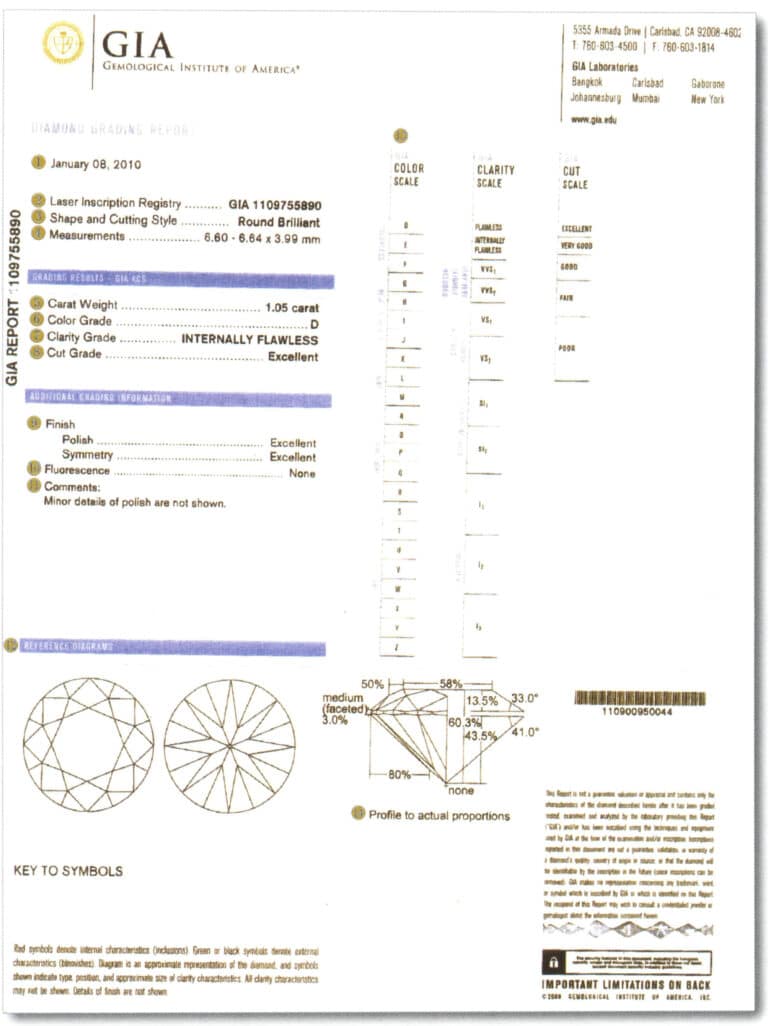
(1) Date
Submission for appraisal time.
(2) Laser Inscription Registry
appraisal number laser inscription number engraved on the diamond’s girdle.
(3)Shape and Cutting Style
records the cutting shape or style of the diamond, for example, Round Brilliant. Other cutting styles (such as heart shape, pear shape, princess cut, etc.) are called fancy cuts.
(4)Measurements diameter and depth
The diameter is calculated by multiplying the minimum diameter by the maximum and height. Unit: mm.
(5)Carat Weight
The weight of the diamond in its raw form is measured in carats. Usually calculated to the second decimal place. 6 Color Grade
(6) Color grading.
The color grades range from grade D to grade Z.
(7)Clarity Grade
The identification results of diamond clarity. It is divided into FL (Flawless), IF (Internally Flawless), VVS (Very Slightly Included), VS (Very Slightly Included), SI (Slightly Included), and I (Included).
(8)Cut Grade
Cut grades include Excellent, Very Good, Good, Fair, and Poor.
(9)Finish
Polish
They divided into five grades: Excellent, Very Good, Good, Fair, and Poor. Usually, the polishing grade of diamonds is around Good; very Good is generally considered better polishing, and Excellent is regarded as the best polishing.
Symmetry
The quality of the cut also depends on whether the overall symmetry of the diamond is complete, whether the diamond is rounded, whether the table and the pointed bottom are off-center, whether the left and right sides of the table are symmetrical, and whether each adjacent edge line meets at a point. Each small facet must also be symmetrical up and down, left and right, which indicates A-grade cut. The grading is the same as polishing and divided into five levels.
(10)Fluorescence
The presence or absence of fluorescence under long-wave ultraviolet light can be categorized into four levels: None, Faint, Medium, and Strong.
The strong blue fluorescence reaction of natural diamonds can make the diamond appear whiter; if there is no fluorescence, it indicates that the diamond is inherently very white, and if the conditions are good, the price will be slightly higher.
(11)Comments
Additional notes on diamond characteristics or other phenomena.
(12)REFERENCE DIAGRAMS Flaw symbol illustrations
Use some graphical symbols to indicate where the diamond has flaws, along with annotations explaining what type of flaw the illustration refers to.
(13)COLOR SCALE, CLARITY SCALE, CUT SCALE
Display the relevant positions of the diamond’s color, clarity, and cut in the GIA grading system.
(14)Profile to actual proportions
Display the percentage data of the proportions and angles of all parts of the diamond.
GIA certificates issued before 2007 do not indicate the quality of cut proportions; they are indicated by cutting. The new version of the certificate no longer includes this item of identification.

| International Gemstone Identification Certificate query website | |
|---|---|
| US GIA Diamond Identification Certificate Query Website | http://www.gia.edu/reportcheck/ |
| US AGS Gemological Society Query Website | http://www.agslab.com |
| Thailand GRS Gemstone Identification Query Website | http://www.gemresearch.ch/Search.php |
PROPORTIONS Cutting Ratio
Depth Full Depth Percentage
Refers to the depth divided by the average diameter; generally, a better ratio in the market is considered to be 52%-62%w
Tabela
Refers to the ratio of the table area covered by the crown when viewed from above, with a standard table percentage of 57%-63%.
Pas
Refers to the thickness of the diamond’s girdle; both too thin and too thick are inappropriate. A thick girdle affects its appearance, while a thin one can lead to brittleness and fragility. Generally, the girdle is described as extremely thin, thin, medium, thick, or extremely thick, with thin to slightly thick preferable.
Culet
Refers to the size of the small facet, categorized as none, extremely small, small, medium, large, or extremely large, with none to medium being considered good.
2. China Jewelry Appraisal Institution
Many people ask me to recommend jewelry appraisers, and here, I would like to offer some opinions for consumers to consider:
Look at the appraiser’s character; no matter how excellent the appraiser is, if they lack good character, they often ruin their years of accumulated reputation for money. The appraiser’s education refers to their professional background. Typically, the heads of appraisal institutions have GIA or FGA certifications. It is even better if the appraiser has an educational background in geological studies and frequently publishes academic research in jewelry or geology-related magazines domestically and internationally. There is the appraisal equipment; besides basic appraisal instruments, infrared spectrometers, Raman spectrometers, or even more advanced instruments are all professional tools.
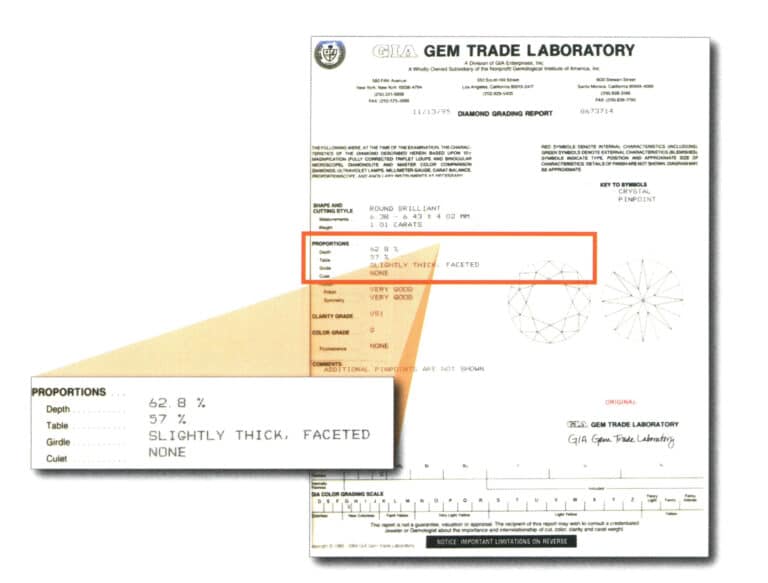
Gem appraisers and doctors are subjective, and their opinions may not align. When Optimized gemstones first appeared, many appraisers were also at a loss, just like during SARS; at the beginning, almost all doctors were helpless, and some even risked their lives. By the time they realized something was wrong, they had probably already issued dozens of appraisal certificates. No appraisal institution, domestic or international, dares to guarantee the appraisal is correct. After two or three years, the same diamond may receive appraisal results that differ by one or two grades from different people or even from the same institution. Because of such appraisal discrepancies, one appraiser jokingly said: If you haven’t been to court as an appraiser, you probably aren’t well-known enough or have appraised too few gems!
Before purchasing gems, consumers should not only look and ask more but also consider listening to the opinions of different jewelry appraisers when buying expensive jewelry. If two or more institutions can appraise the same gem simultaneously, the results are usually more objective. Consumers should ask friends, family, or experts for advice when choosing a jewelry appraisal institution and communicate fully with the appraiser. If you need to appraise an unknown mineral, you can conduct an X-RAY mineral composition analysis, electron microprobe, and electron microscopy analysis (EDS).
Section VIII Introduction to Basic Tool Usage
Correctly using a gem loupe and tweezers lets you clearly see the inclusions and distribution when purchasing a gem. Still, it can also showcase your expertise, letting the seller know you have received basic training in gems and preventing arbitrary pricing.


(1) Place the gemstone face down, aligning the gemstone with the front edge of the clamp.
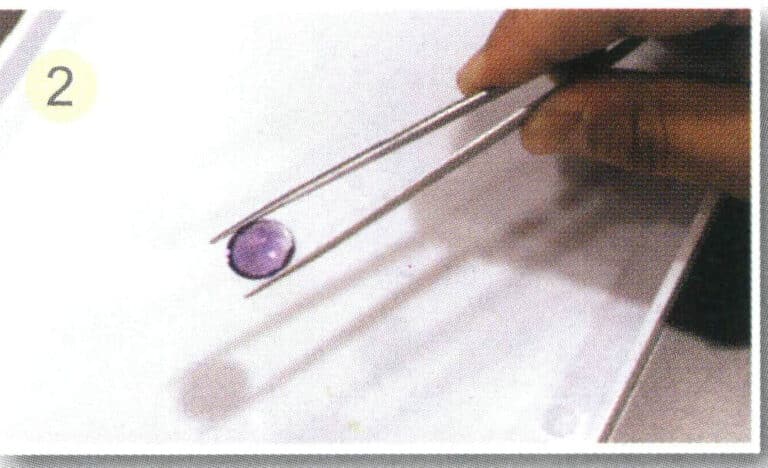
(2) Hold the gemstone, ensuring it does not extend beyond the end of the clamp. Hold the clamp with your hand positioned slightly lower in the middle.
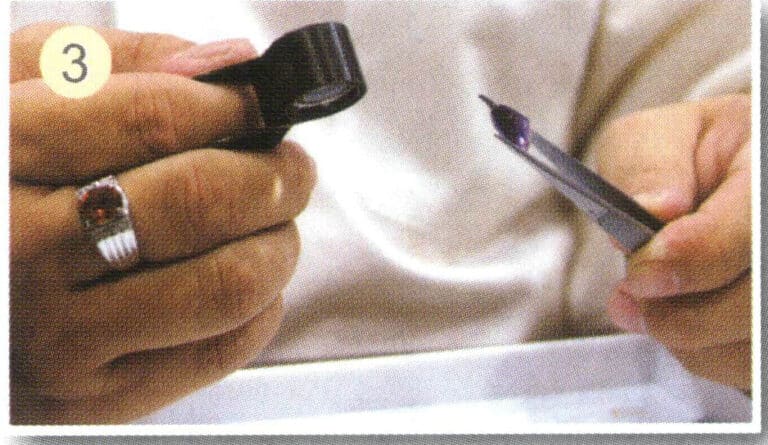
(3) Hold the magnifying glass, placing your index finger inside it and securing it with your thumb and middle finger.
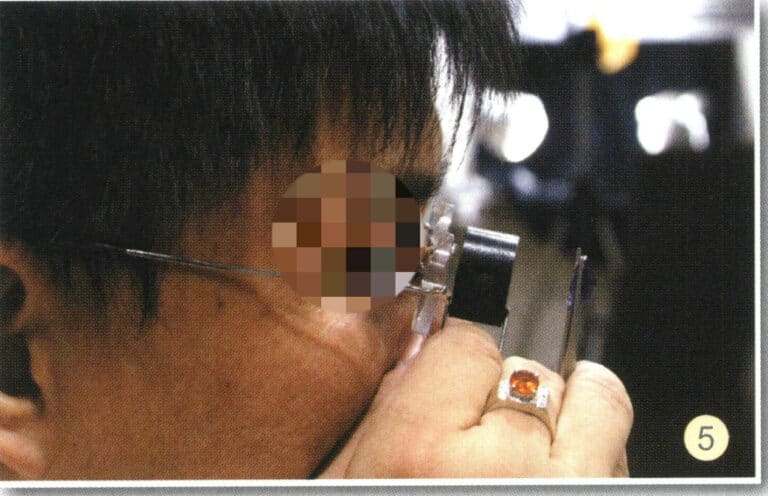
(5) Bring the gem close to your eyes, with your thumb pressed against your cheek. Look straight ahead, keeping your eyes as wide open as possible. If you are not used to it, you can close one eye. First, observe the front of the gem to see if there are any inclusions, whether the surface polishing is bright, and if there is any wear on the cutting surface. After observing the front, continue to observe the back of the gem. While observing, move the gem back and forth to adjust the focus until it is the clearest.
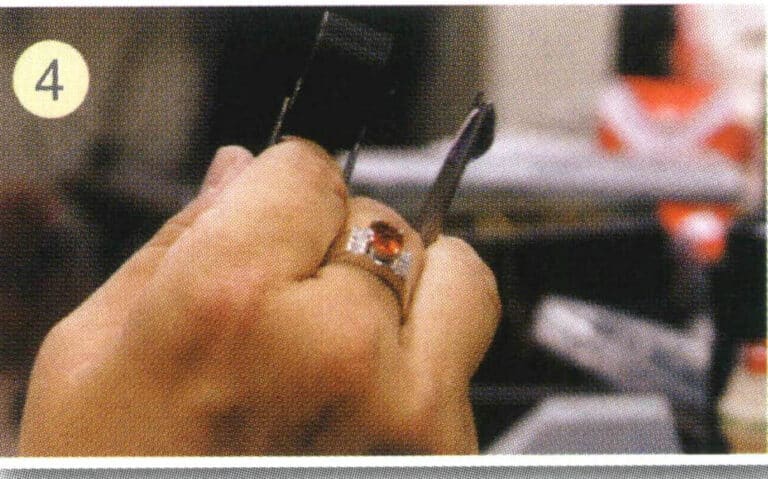
(4) Move the gemstone under the magnifying glass for observation (between the middle finger and ring finger). The magnifying glass should be parallel to the clamp and not extend beyond the top of the magnifying glass.
1. How to measure the refractive index of a gemstone?
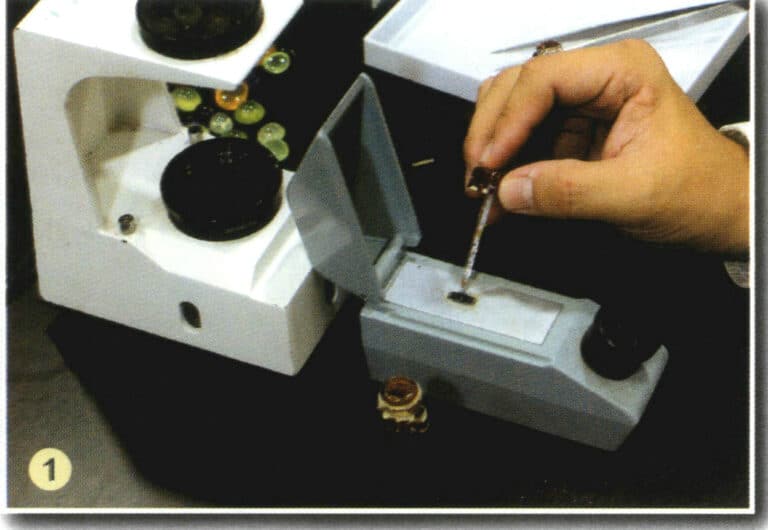
(1) Drip by drip in the refractometer 2-3 millimeters of refractive liquid.
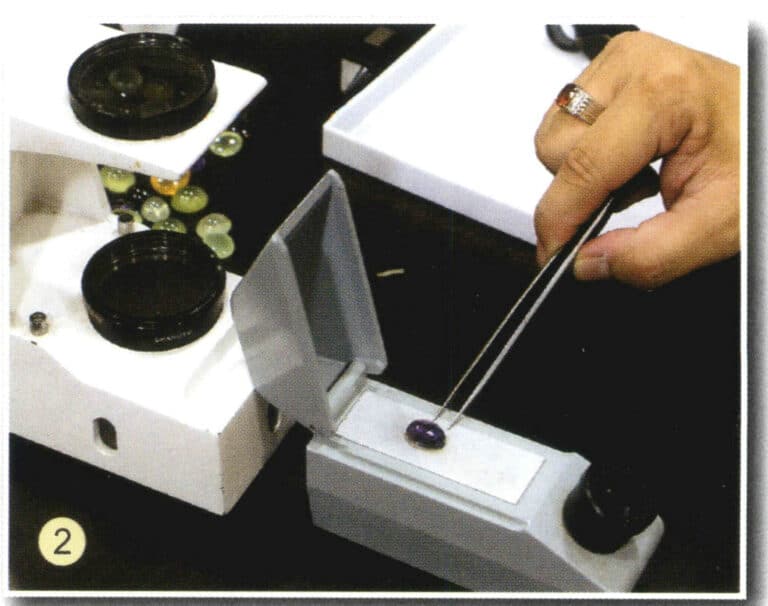
(2) Place the faceted gemstone with the table facing down on the glass. The cabochon or opaque gemstone should have the convex side facing down.

(3) Turn on the light source and close the lid.

(4) Bring your eyes close to the refractometer and observe the refractive index of the gemstone. Use the near measurement method for faceted gemstones and the far measurement method (about 25-30 centimeters from the eyepiece) for cabochon gemstones.
2. Demonstration of various instrument operations
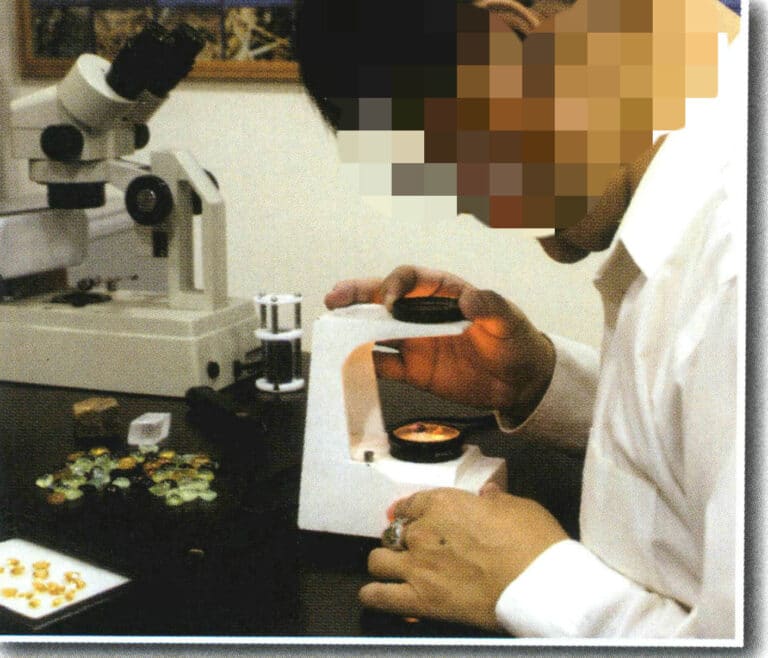
Observe whether the gemstone has birefringence using a polarizing filter, such as distinguishing between ruby and spinel.
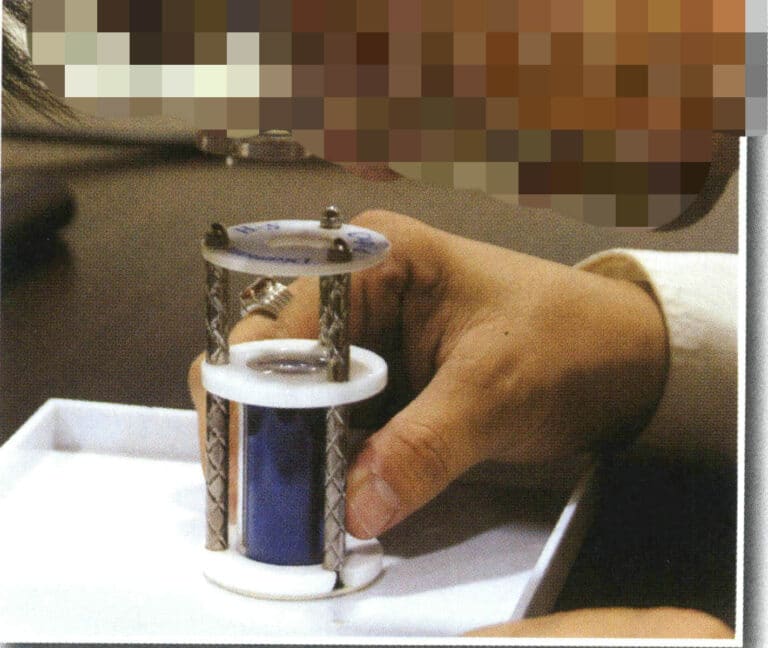
Check if the round brilliant diamond has eight hearts and eight arrows.

Use a penlight to observe whether the gemstone has cracks. A penlight can also be used to observe star effects or cat's eye phenomena; a yellow light source can also be used to check for color change in the gemstone.
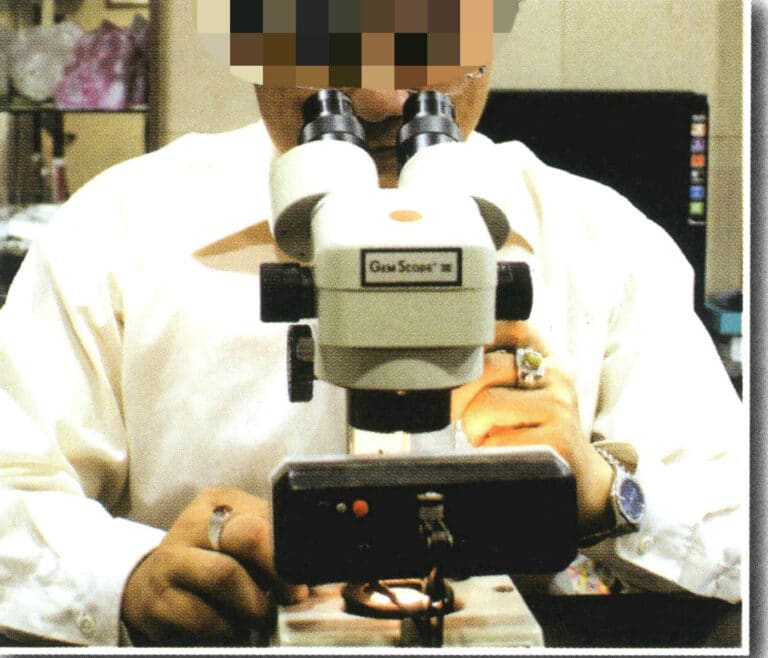
Use a microscope to observe inclusions in the gemstone, preferably with both eyes open. First, adjust the inter-pupillary distance until two images merge into one, then change the microscope magnification from low to high to locate the gemstone.
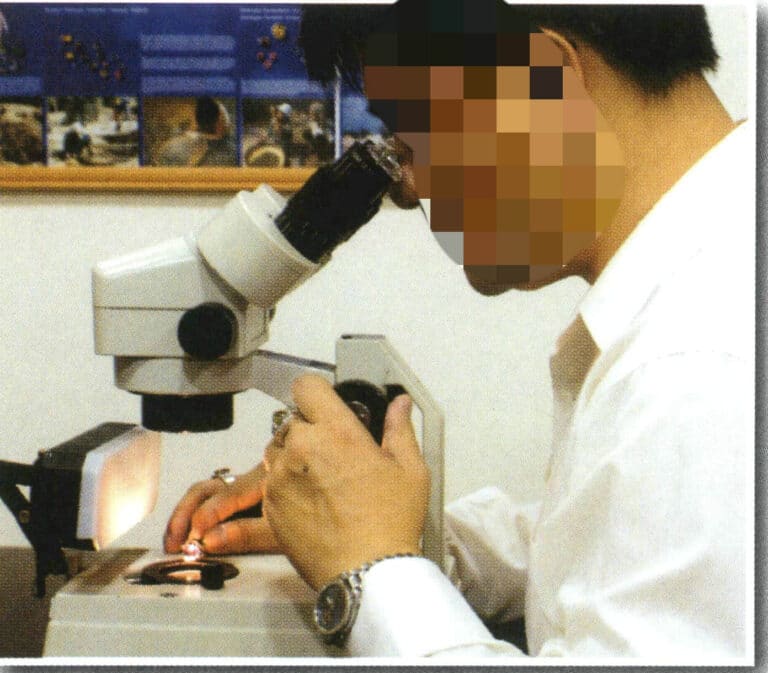
After seeing the gem, adjust its position slightly with the right hand and fine-tune the focus with the left hand until the distribution and types of inclusions in the gem are visible.





